Archives
now browsing by author
How Many More School Days Until Summer??
by Jessica Alesso
Oh, the holidays. A great time of excitement, joy, and revelry for most, paired with a bit of stress, busyness and travel, too much food and drink, and perhaps not as relaxing as we all had hoped. BUT, we as teachers crave this mid-year break, right? We are all anxiously—students and teachers alike—counting the minutes until that bell rings on the last day before vacation starts. We try desperately to keep them all engaged right up until the end, despite their antics and their evident desire to also be out of the building, sleeping in, opening presents, and enjoying this chance to recharge our batteries, at least a little bit.
I always have the greatest intention to bring a ton of grading home, but I inevitably push it off until the last day, and then have less-than-zero motivation to do it. Instead, I spend my time on Pinterest and YouTube, watching gelatin printing and mixed media videos and plotting how to use the techniques in my classroom. I also spend a fair amount of time “art-ing,” retreating to the studio, and refocusing my artistic energy into productivity rather than regretting the amount of carbs I’ve ingested and the amount of money I (over) spent. I often find myself making plans to continue my art mojo throughout the year too, as the creative momentum I build over the break will wane. As artists and as teachers, we need this time to just be, to think, to plan, and to live in the process, until the magic happens. After all, isn’t that precisely what we teach our students to do? So, as we count down the precious moments until we have to return to the daily grind and to help our darling students make artistic magic, let’s reflect on how we can keep our own juices flowing, until those last few days in June (that’s still six months away, right? Oh, boy).
-
Start a new art journal or sketchbook
One of my favorite ways to reinvigorate my artistic practice is to start a new art journal. A go-to gift that my family knows will please me is a gift card to my favorite art supply store. So I usually pick out my next sketchbook well in advance of Christmas, in preparation for that virtual money to start burning a hole in my pocket! That fresh, clean paper nearly screams to be covered in watercolor and acrylic, in chalk and graphite, and my latest material obsession: Distress Inks.
-
Sign up for an online workshop or class
I didn’t even realize how many options there were for this until a friend of mine suggested that we do one together. There are TONS of options out there, focusing on materials such as watercolor or fluid acrylic, paper arts, or polymer clay, or centering on processes such as collage, printmaking, abstract painting…not to mention those that are concept-based, such as “reclaiming your creative feminine energy” or “designing installations.” Just do some searching! Seriously, just Google “online art workshops about ______.” Whatever floats your boat, you will be able to find an online experience to suit you. If you don’t have the cash for that option, plan to view some PAEA WebinARTs! Check for new content by clicking here: WebinArts
-
Set aside time for creative goal-setting
This is one I struggle to do sometimes, but I always have a more productive year of art-making when I do it. Before the crazy of the latter half of the school year starts, set aside a weekend day or evening to look ahead for upcoming opportunities. My local art museum has an adjudicated spring show, in which I have sporadically participated over the last decade, and I know if I planned ahead for it, I’d be motivated to make more work. A few summers ago, some friends and I planned a group show for a small local venue. Having the accountability of a group was essential for me to push through and make art, and ultimately, I came up with some of the best work I’ve made in several years. If you can dream it, you can do it, right? I know I’ve had that quote on a poster in my classroom at some point. Walk the talk.
-
Make time for art in your week
This is a practice that has made a world of difference for me this past year. In June, I had breast-reduction surgery, and I was laid up for almost the rest of the summer. Making art was about the only thing I had energy for during those first few weeks post-surgery, so I was forced to indulge myself in painting, Gelli printing, playing with watercolors and the myriad markers I’ve stockpiled. I even revamped my art website (well, started it anyway…that takes FOREVER, and I have miles to go). When school started, I made a point to continue my studio time for at least one day a week. Though it may only be for 20 minutes here and there, I’ve kept at it and nearly filled an entire sketchbook.
-
Find (and engage with) your tribe
This is one of my favorite “art” practices, and I always feel justified making time to hang out with my art/art teacher friends, since I’m supporting my creative identity and satisfying my penchant for being a social butterfly. Finding those people who get us, and who get what we do on a daily basis, can be a huge benefit for us; energetically, spiritually, emotionally, and practically. Most of the inspiration I get for my own art is from collaboration with friends and colleagues. This is perhaps the main reason I attend the PAEA conference. Not only do we get Act 48 hours and great insights into new methods and materials, but we also get to hang out with our tribe, our people, and art-nerd out together!
Jessica Alesso is a secondary art teacher in Erie, PA and the Region 2 Representative for PAEA. Jessica is also the co-chair for the 2020 PAEA conference committee and is excited to welcome Pennsylvania’s art teachers to Erie in the fall.
Arts Integration – Good or Bad?
Have you recently heard a lot about bridging learning by connecting student learning outcomes across disciplines? This seems to be all the latest language across the pedagogy stage. Believe it or not, as art educators, we have been doing this for centuries!
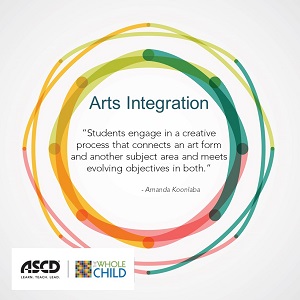
Art education is a discipline that not only enhances creative thought and the ability to abstract answers from complex experiences, we also use multiple disciplines and content areas as part of our strategic tool belt. This is not to be misinterpreted as an arts integration model where visual arts constructs are brought into the content area classrooms as interventional strategies or enrichment activities. That is very valuable as well, but we want to celebrate the arts as a stand-alone course.
Instead, it is time for us to deliberately inform our students of the information behind the curtain –what are materials or why materials work in their own particular ways. Not just a crayon, it is a low melting point wax that with slight friction can transfer onto a sheet of paper.
In addition, we need to inform our students about the importance of history, culture, and diversity play in particular art forms. As artists, we use math all of the time. Explain this to your students, even kindergartners can learn that we need to add and subtract when creating certain things. High school students should understand probability and predictions and their outcomes.
Thank you to the STEAM movement for reinforcing our place value in the educational system. I know that it is a lot of work on the back end to incorporate this into a paper trail, but administrators will be highly pleased with your work. And ultimately, students will benefit from these connections.
The SAS portal has several resources regarding these practices. In addition, The Kennedy Center has some amazing resources regarding arts integration. You may also benefit from articles regarding “what arts integration is not…” Enjoy!
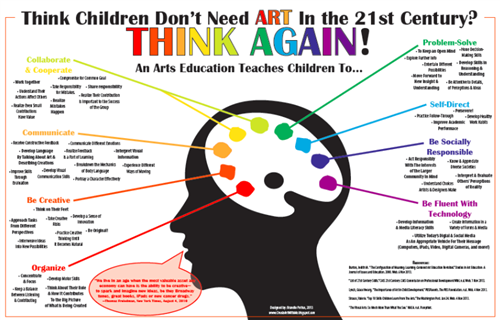
Please contact Dr. Stacy Potter, PAEA Advocacy Chair for more information.
Interdependence Hexagon Project: You are Invited!
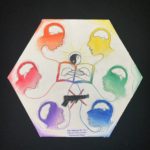
Blog Post from Beth Burkhauser and the Interdependence Hexagon Project
The Hexagon Project is an international visual arts initiative. Our mission is to spread the idea of Interdependence through student- and community-created hexagons. The hexagon is the metaphor for interconnectedness and, since our founding in 2016, over 10,000 artworks have been made worldwide. We are launching our 2020 project in October, our 14th year!. Themes of social justice, peace, global citizenship, cultural diversity, identity, and environment are expressed through the power of the arts.
Our 2019 Theme was Transforming Conflict and our Eastern Regional Exhibition [PA, NY, NJ, DE, MA CT] opens in Scranton, PA on September 6 and runs through the month.
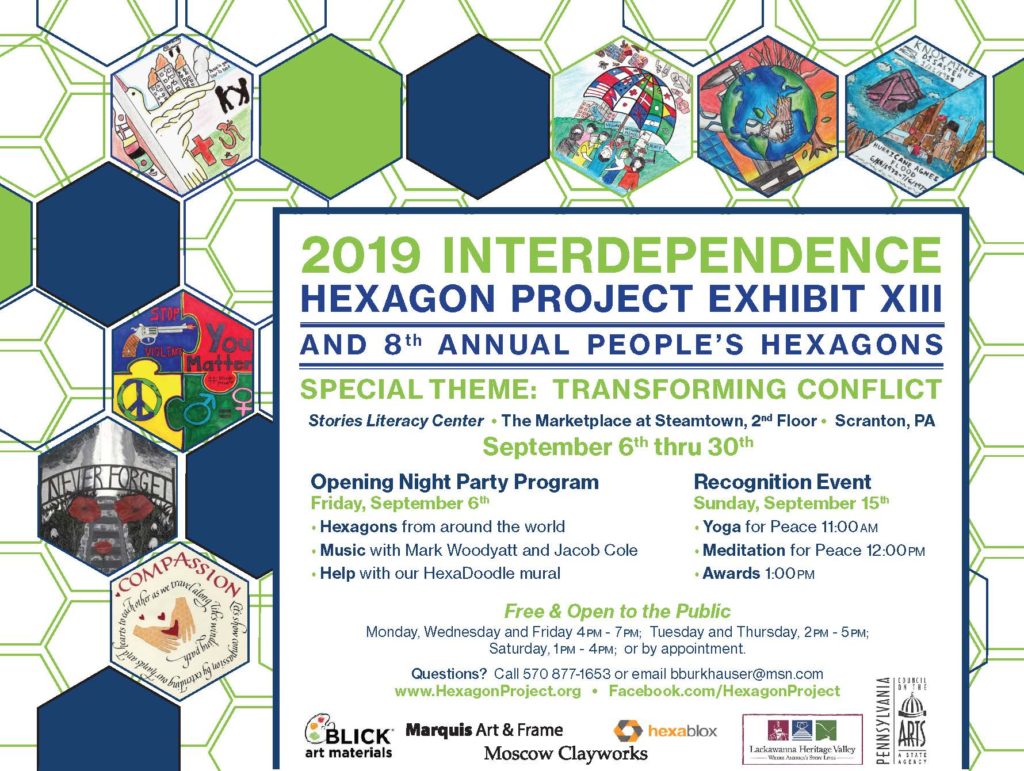
The Project is free, WEBSITE [www.hexagonproject.org] offers free resources, templates, lesson and unit plans, worksheets, video, and PowerPoints to introduce the Project. Open to all ages, all media, ripe for strategies such as Choice, Integrated Curriculum, TAB and 21st Century skills, align with Next Gen Arts Standards. Teachers join and then upload artworks. 2020 DEADLINE: June 30, 2020.
NEW: we have a searchable Online Gallery where all hexagons can be viewed and a Blog-space which will feature global teachers’ stories about how, why and where hexagons are made plus opportunities to connect with others.
WANTED: participants for our 2020 Project and 2020 Project SPECIAL THEME: DIVERSITY. Brainstorm ways to think diversity! Could we today see the challenges of inclusion and acceptance of difference as the challenge of a process of transformation? Fertile ground for a shift of mindset with the infusion of new ideas attitudes and focus that results in outcomes that can transform our future on this planet.
OR…
Perhaps consider DIVERSITY as a self-selected problem-solving design thinking process that resembles an alchemical transformation – as in the medieval attempts to convert base metals into gold.
Fertile ground for a shift of mindset with the infusion of new ideas attitudes and focus that results in outcomes that can transform our future on this planet. Students envision this process using hexagons and share it with the world…
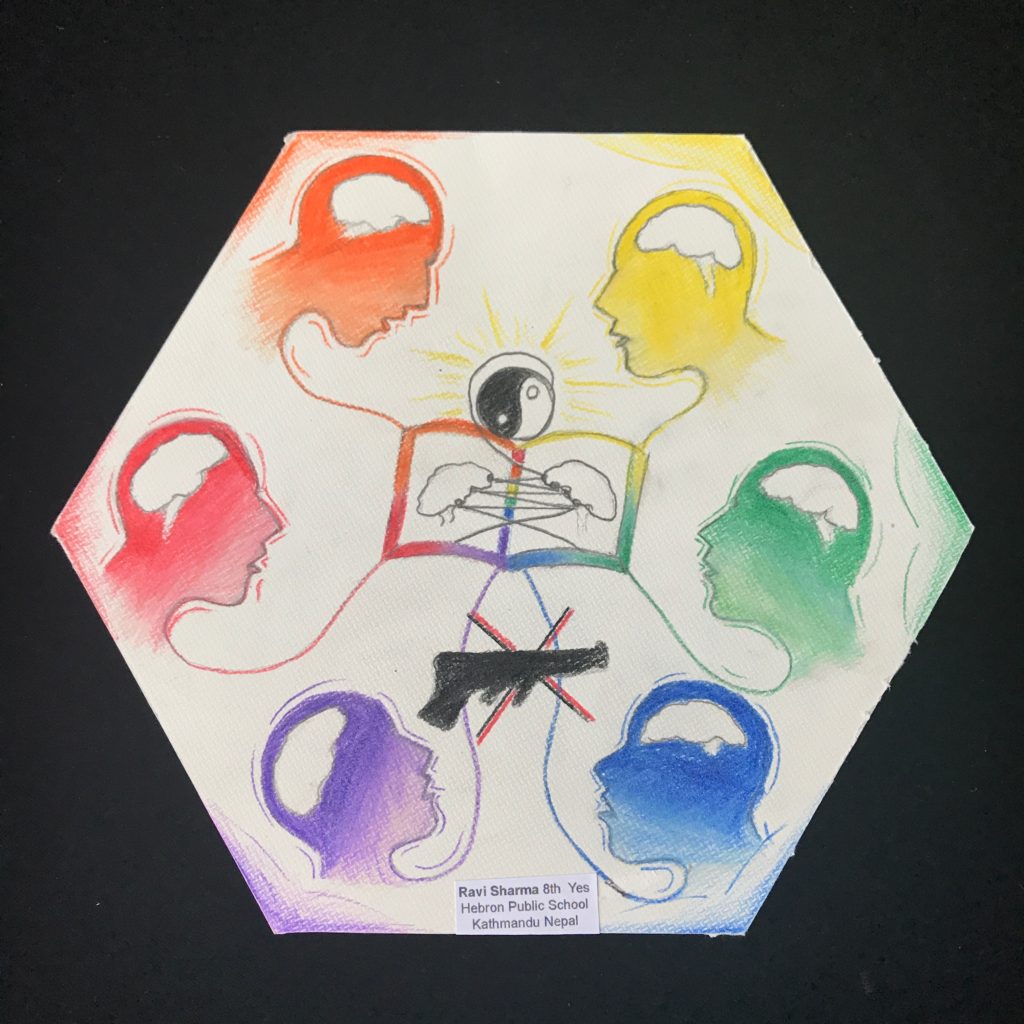
DIVERSITY can also refer to diverse learning styles, cultural diversity of art, music, dance, food, etc, Fusion. Bio-Diversity of plant and animal life as well as human and technological diversity – using the multitude of available and developing tools for good.
Here are some resources for you:
https://www.tolerance.org/topics/race-ethnicity
Resources about living in a diverse world.
Some sections of resources on diversity from Vanderbilt University
Lastly: This Hexagon Flying Pencil came from Kingdom Kids International School, Nigeria [Olaniyi Sunday Olaniran, Art Teacher]! It is meant to travel and house hexagons! In 2019 it took a beautiful metaphorical journey from Nigeria to Howard Gardner School, Scranton [Melissa Cruise, Art Teacher] to Stephen Girard College, Philadelphia, PA [Christine Enedy, Art Teacher] and we are looking for other venues for 2020! Contact the author if interested.


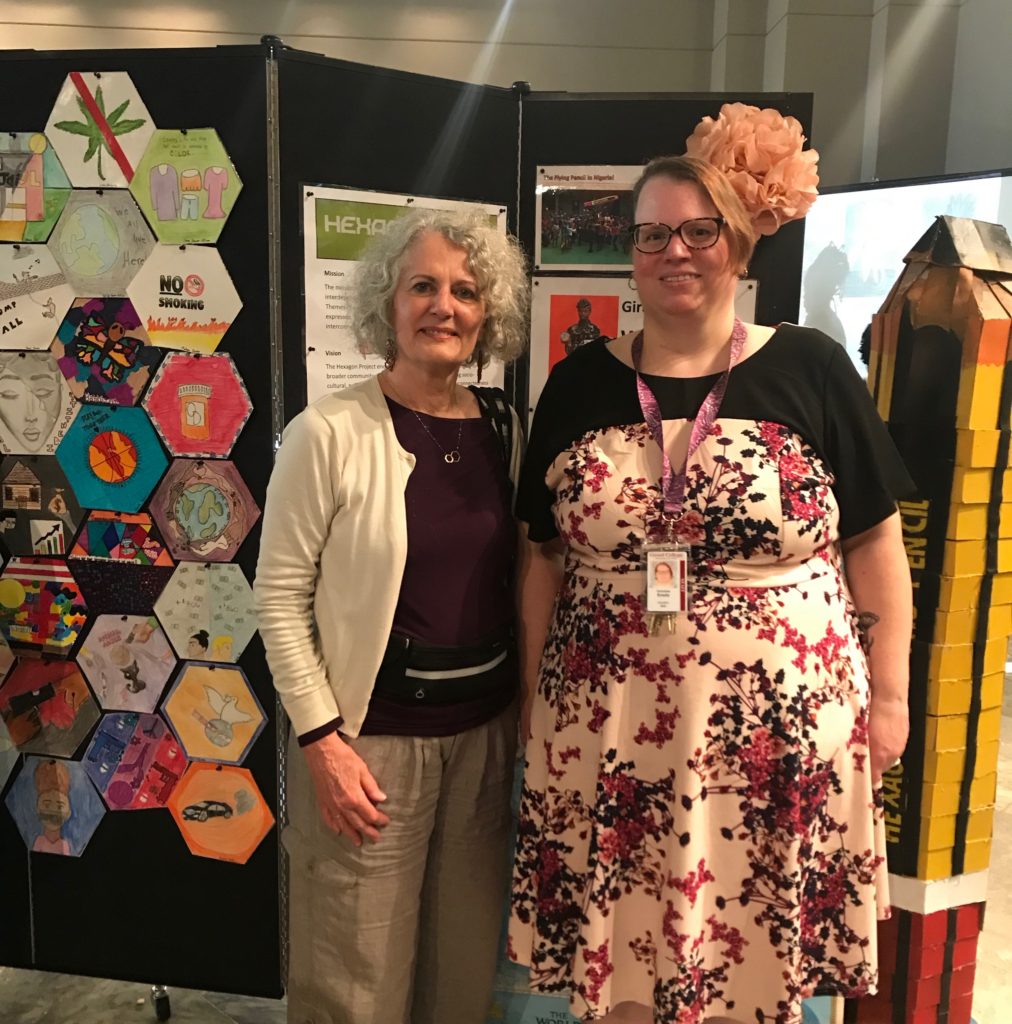
Beth Burkhauser is Adjunct Professor, Keystone College Art Education.
She is a 35-year veteran art educator in Pennsylvania Public Schools and
Founder of the non-profit, Interdependence Hexagon Project.
She was named 2016 NAEA Educator Emerita and is a
PAEA Fellow
Contact: www.hexagonproject.org
bburkhauser@msn.com
570 877-1653
Creating a Staff Mural & Building Morale
This blog post is contributed by Jes Noel. Jes
As art educators we create art with our students however have you ever considered creating art with your peers? And I am not talking fellow art teachers I am talking about the other educators in your building that DON’T teach art! Well, I am here to tell you it is possible!
This past 2018 – 2019 school year I created a staff mural with my fellow 70 educators, paraprofessionals, administration, secretaries and custodians. With the help of my building principal, we found time in six-morning meetings throughout the year to create our mural with was unveiled in April during our annual Celebrate the Arts Night. Our inspiration came from the street artist Kelsey Montague and her #WhatLiftsYouSchools movement.
First Morning Meeting:
I prepared a PowerPoint to explain to staff what our initiative for the year exactly was. Our Goal: create a staff mural to gift to our students in April inspired by Montague’s wings which also tied into our new social media initiative. #ironkidssoar
Second Morning Meeting:
Staff painted two pieces of paper with acrylic paint which would ultimately be turned into 4 feathers per staff member. Staff was limited to red, orange, yellow, blue, green or purple paint.
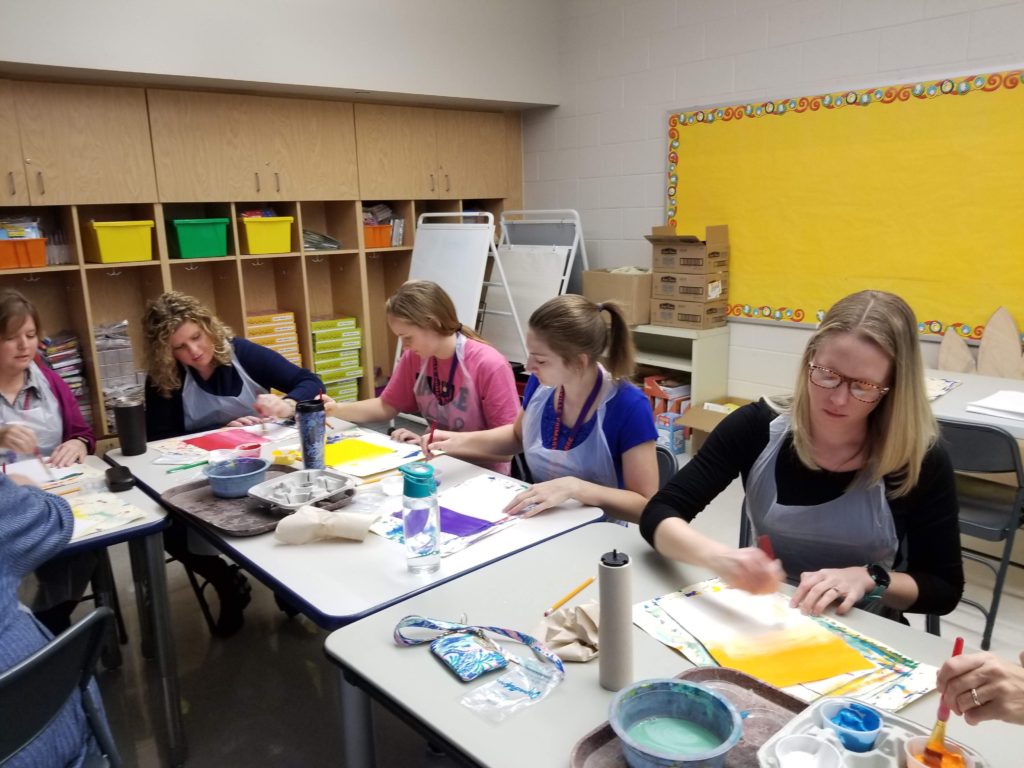
Third Morning Meeting:
Staff were introduced to the Zentangle Method and practiced Zentangle on a 3×3 square.
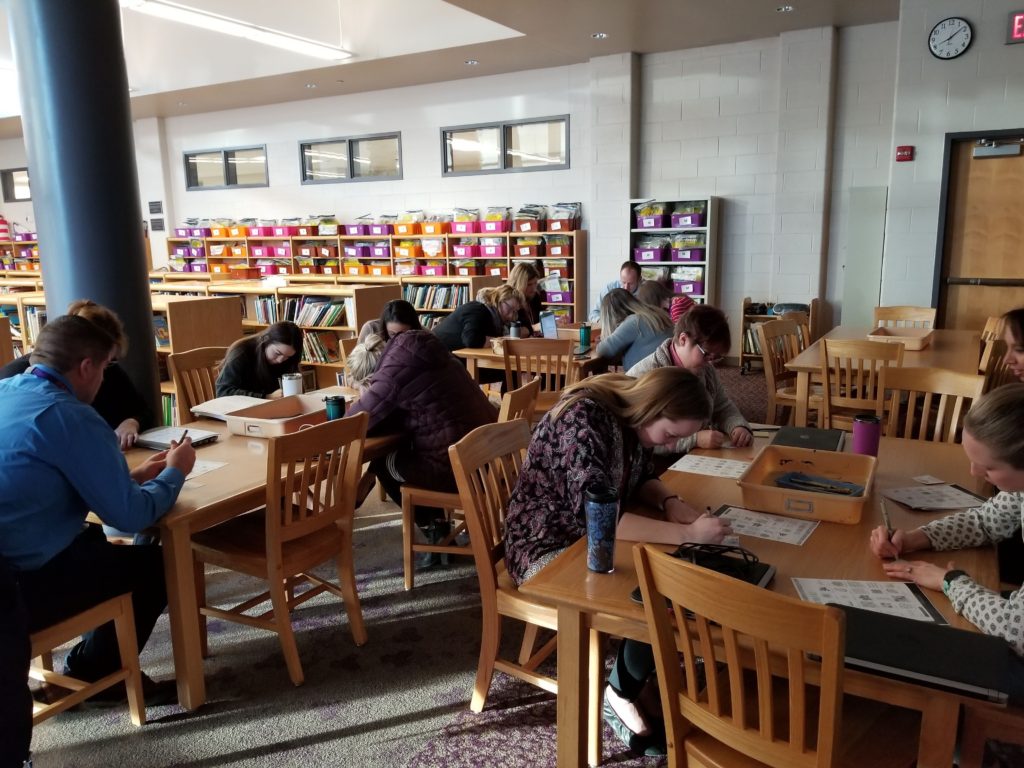
Fourth Through Sixth Morning Meeting:
Staff Zentangled two of their four feathers for the mural. Feather stencils were provided for continuity along with multiple handouts and examples. The other two feathers remained blank.
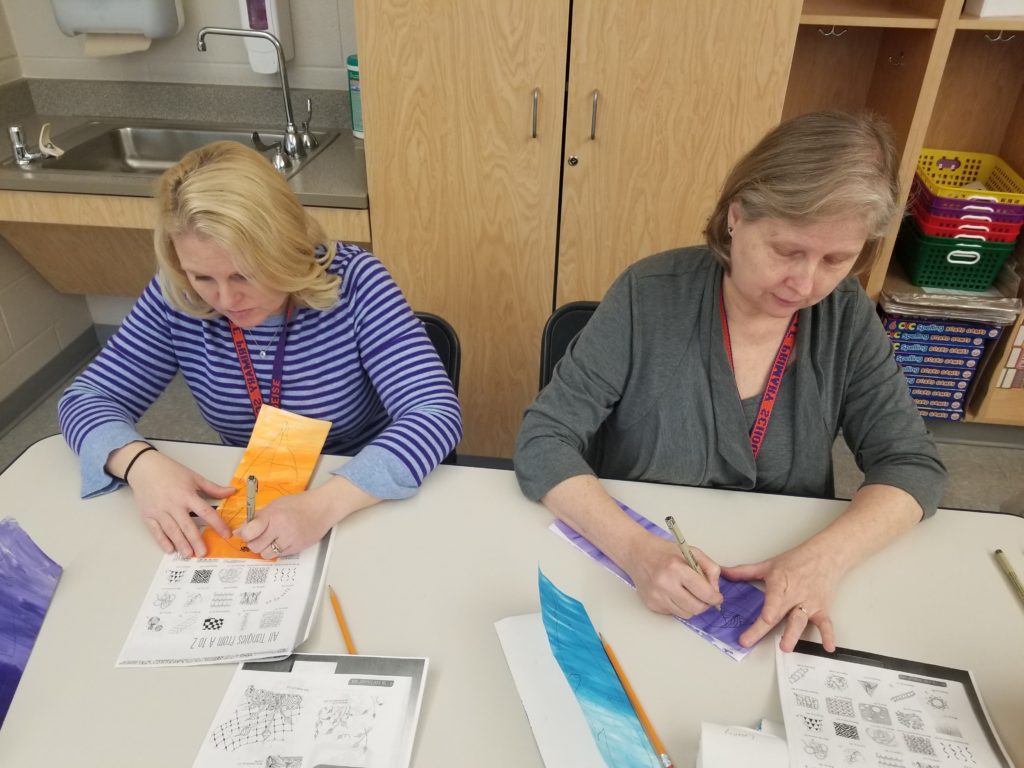
Upon completion of all the feathers after the sixth-morning meeting, I and a fellow first-grade teacher began the process of laying and gluing all 280+ feathers onto plywood that we had cut into the shape of wings.
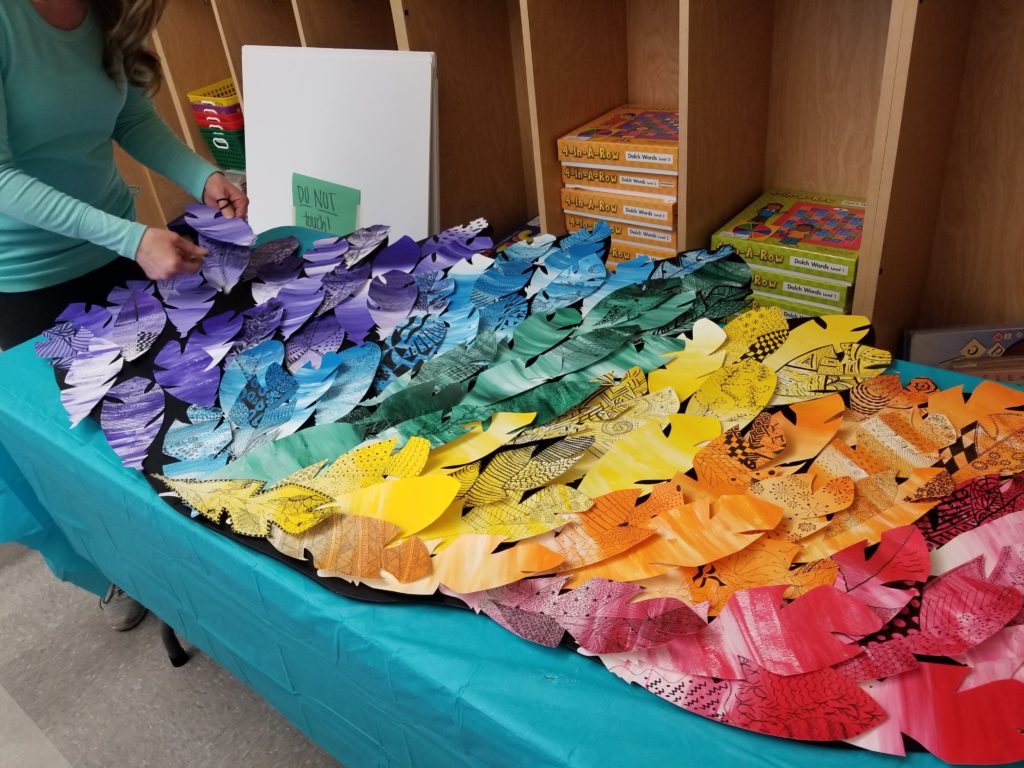
After many, many, MANY coats of Mod Podge, the wings were ready to hang! The staff had voted to entitle our group mural “At DPS, Our Dreams Take Flight.” With the help of our maintenance department, we hung our wings in the main hallway for prime viewing and interaction.
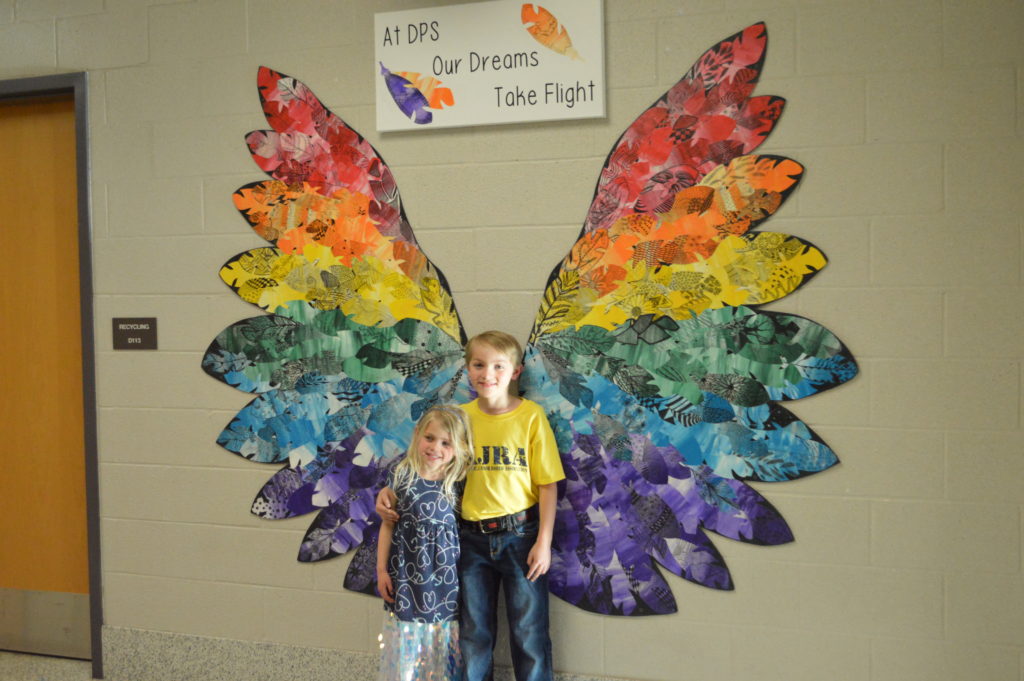
PA Arts and Culture Advocacy: Engaging Students in the Political Side of the Arts
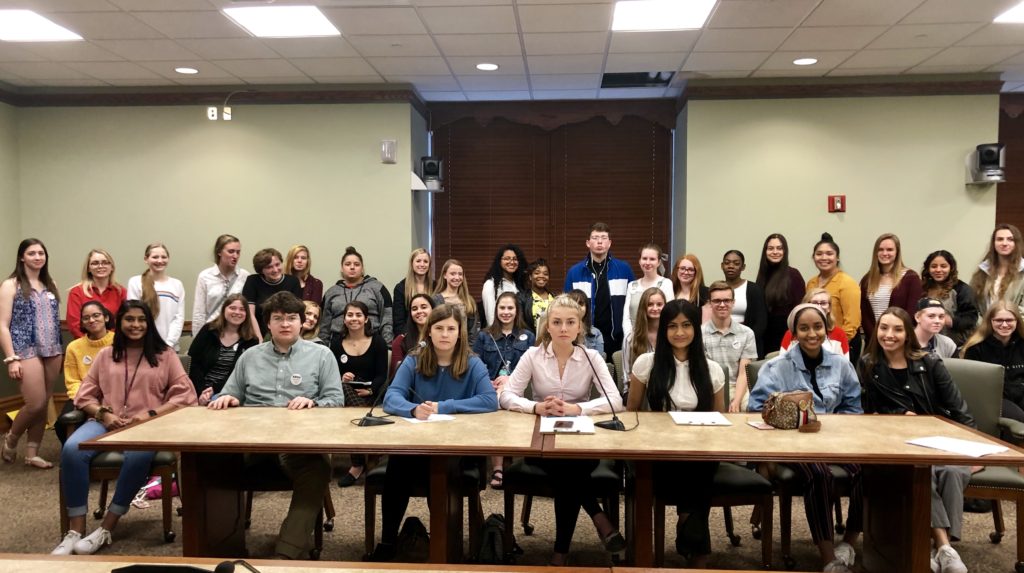
Post by PAEA board member Jessica Kirker
“I only need to pass my ‘important’/core subjects.”
“[Student] is going to have to miss art today because of discipline/make-up work/test prep.”
“I can’t expect [child] to do well in art, I can’t even draw a stick figure.”
“It must be fun/easy to teach a class that all students enjoy.”
“How can your really grade art? Art can just be whatever you want, right?”
I am certain, beyond a doubt, that I have the best job in the world. If you are reading this blog, you probably do to! We, as art teachers, have so much to be grateful for. We have the privilege of enlivening the creative spirits of those whom we teach. Art teachers can foster a means to communicate beyond what a student expects or imagines of themselves. We can open eyes, heads, and hearts to media and methods that our students didn’t know existed. We get the chance to re-experience the joys, excitement, and apprehension of these materials and tools for the first time over and over through our students. While students transition through grades and classroom teachers, we get to stay with students for years and have the chance to build meaningful and lasting relationships.
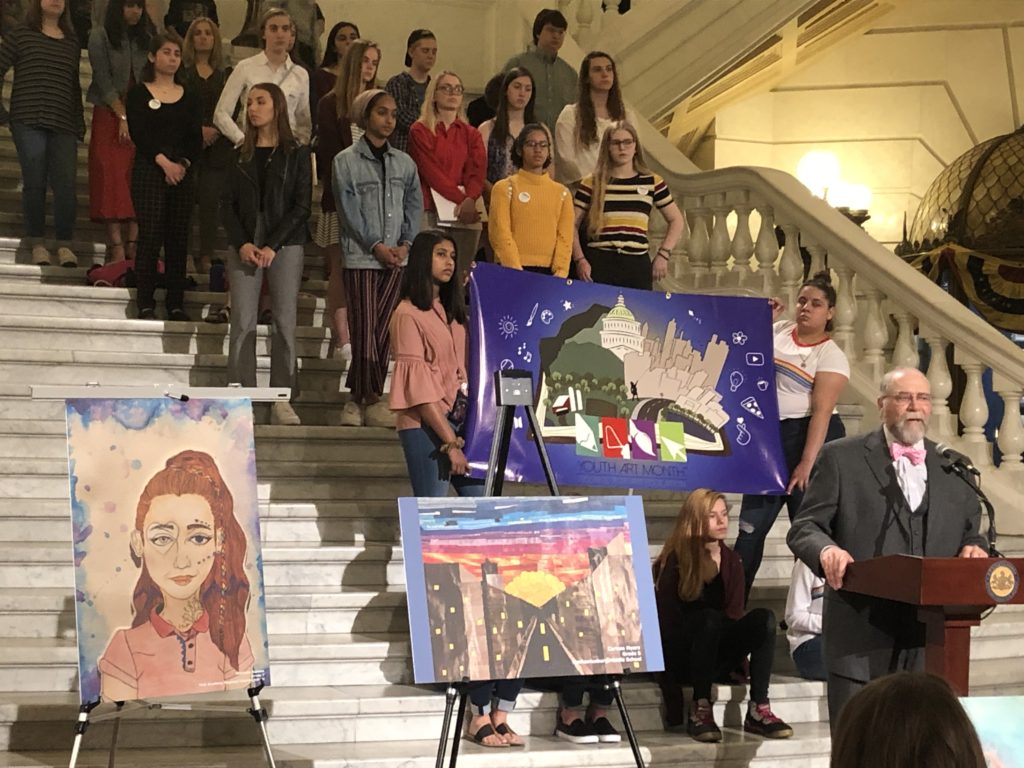
However, some times, (ok, many times) we have to grit our teeth to the misnomers that come from a lack of understanding about what we do, and most importantly, why we do it. The readers of this blog know that we are not the educators of fluff, fun time, brain breaks, hobby hour, extra recess, or easy ‘A’s’. Sometimes these misnomers are cruelly condescending and other times they are ignorantly based on affectionate nostalgia. Whatever the reason, these perspectives are damaging to the future of art education for all students and we can not allow them to continue.
NAEA and PAEA both provide strong support for art education advocacy. (Have you checked out their websites lately? NAEA: https://www.arteducators.org/advocacy PAEA: https://paeablog.org/blog/.) NAEA offers a multitude of materials to assist art educators in preparing to advocate to school, community, and legislative audiences. These well-articulated resource guides plainly and effectively describe the importance of art education for all students and are easy to be shared with educational community stakeholders.
I am proud to report that this year some members of the PAEA Secondary Division incorporated high school students into their advocacy plans for PA Art Education by bringing approximately 50 high school students together for Pennsylvania Arts and Culture Advocacy Day in Harrisburg on May 1. This event was sponsored by The Citizens for the Arts in PA and exposed students to the political side of the arts while showing our legislators the importance of art education on a very tangible and personal level. The art teachers from Norristown Area HS, Garnet Valley HS, Cumberland Valley HS, Conrad Weiser HS, and South Western HS each brought between 5 and 15 students to participate in the day’s events. The majority of these students were members of their school’s National Art Honor Society Chapter.
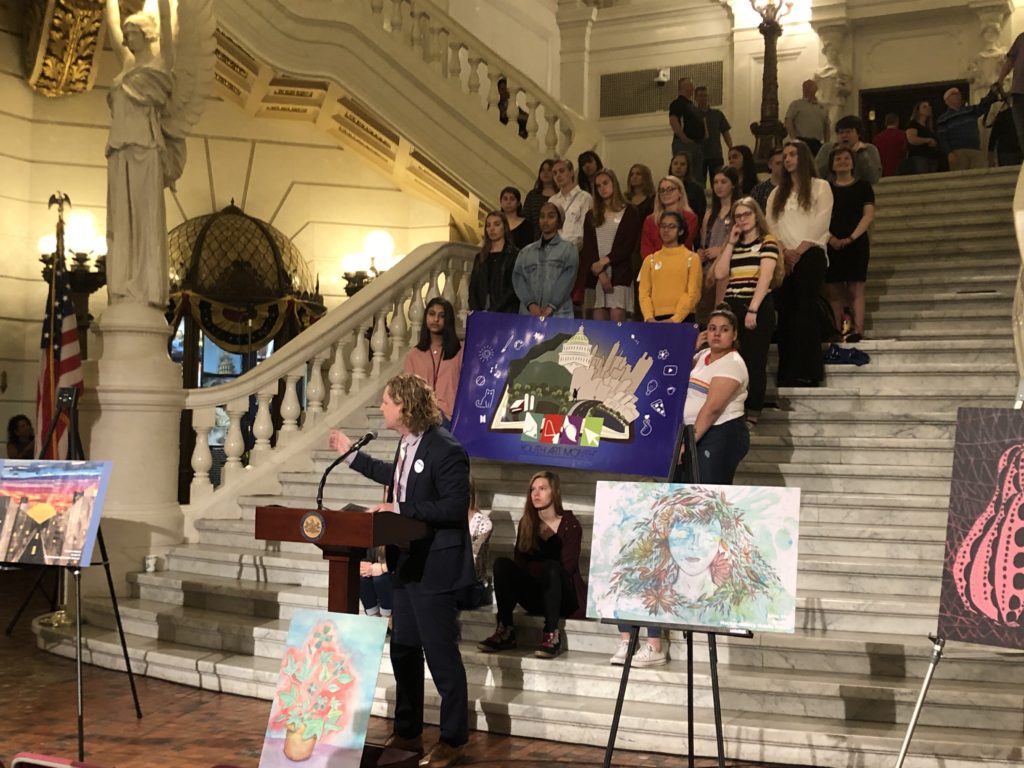
The day began with an Arts Caucus breakfast followed by a press conference in the Capitol Rotunda. During this time, some high school art students proudly displayed the PAEA 2019 Advocacy Flag in the backdrop for the speakers. Easels of PAEA Youth Art Month surrounded the podium and Rotunda stairs, attracting the attention of those that passed by. Meanwhile, other art students grabbed their pencils/pens/markers/charcoal and began drawing the architectural landscape of the building as observers got the opportunity to see our talented students at work. These working artists put the process of their craft in the limelight to the capital audience.

After the press conference, some students took part in tours while others continued drawing exercises or moved on to legislative meetings. Jenny Hershour of Citizens for the Arts in PA coordinated the meetings between participating schools and local legislators so that they could engage in conversations about the importance of arts education from the perspective of those whom are directly served. This gave the students the chance to speak from the heart about their passions, inspirations, educational experiences, and hopes for the future of art education.
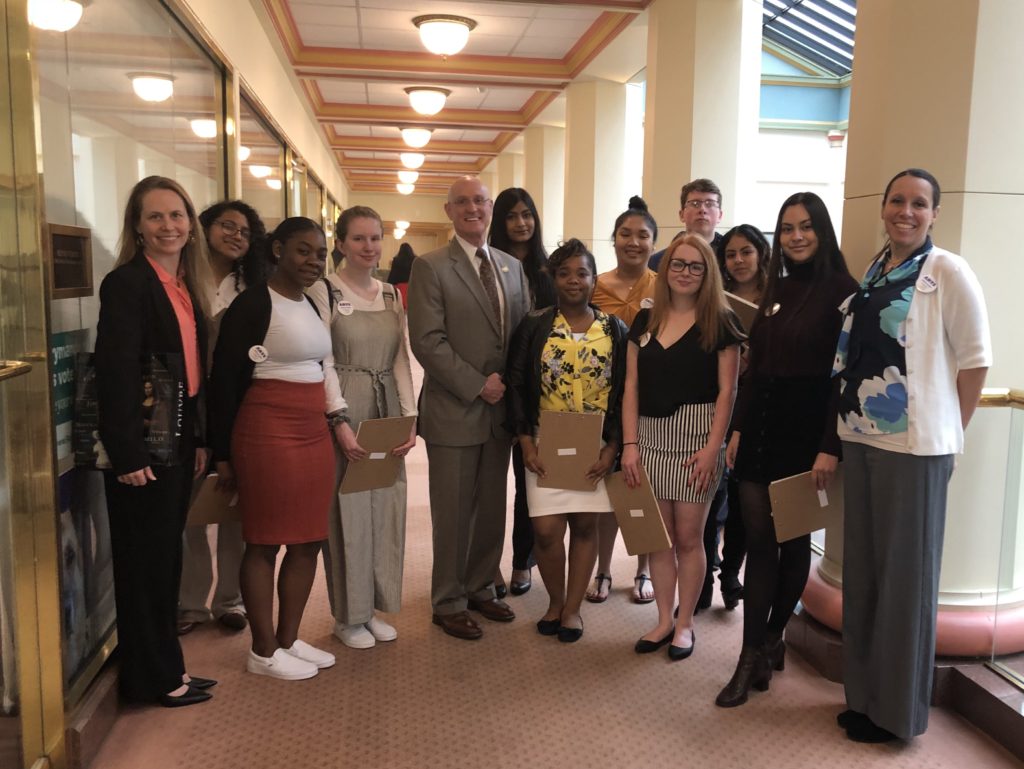
All students attending had the chance to get together over lunch where they were assigned to tables with youth from other schools. Uncomfortable at first (as you can expect of any high schooler), the tables transitioned from shy nerves to lively chatter and laughter by the end of the afternoon. With the conclusion of
Not only did the students get the chance to have their voices heard and create visibility for the visual arts during this event, I believe the most impactful outcome of the day was the effect that this even had on our students. Many high school art students are familiar with the misnomers surrounding art classes. By the time they have reached high school or advance level classes, there has been some tough choices to be considered. Do I take another year of language or try for AP studio? Do I need another math class or can I take Art II? Will it affect my GPA if I take non-weighted art classes? Do I want a career in art? Whatever their reason, these students have chose the path of including visual art into their educational path, and they might have had to defend this choice to peers, teachers, or family members. Are they prepared to successfully articulate their position? We, as members of PAEA/NAEA have been prepped for these conversations, but what about our students?
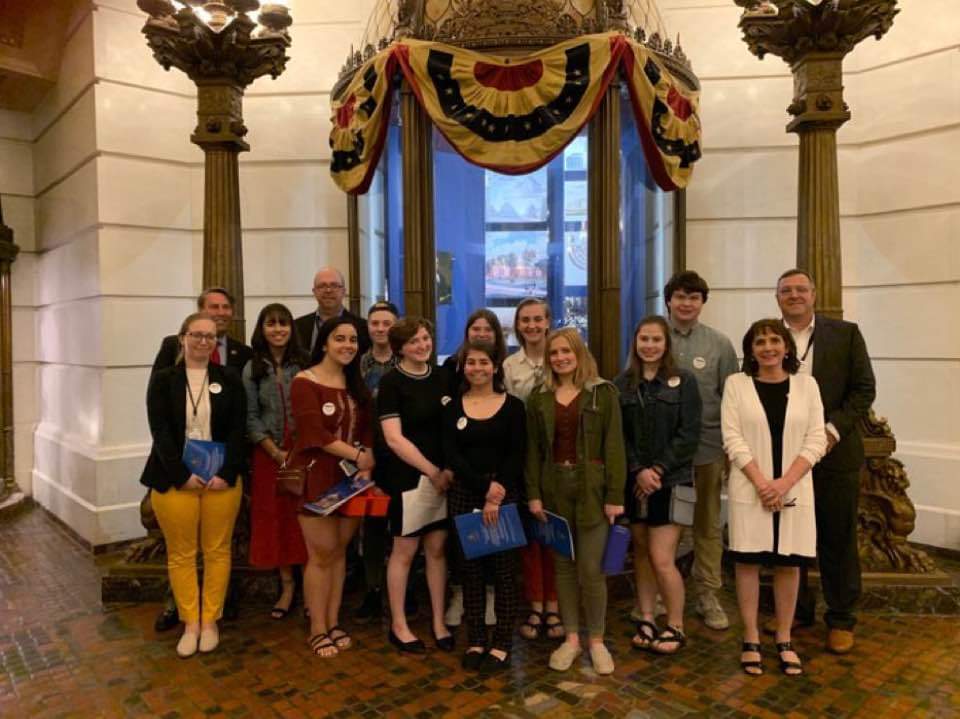
If a student is going to join the art world as full-time or part-time professional artist or art educator, patron of the arts, or supporter of the arts, s/he are members of an arts community that does not exist in the solitude of his/her own space. We teach our students that art is social, political, emotional, and environmental. Therefore, engaging the arts world is also a socio-political activity. If we teach students how to make art, talk about art, analyse art, and write about art, then we also need to consider it our duty to teach our students to be citizens for the arts.
There is evidence to support the notion that regular exposure to art classes enhances proficiency in math and reading. Can we look to sociology to enhance our understanding of art or government/social studies classes to enhance our roles (or our students’ roles) as art advocates? It is not rare for my high school art students to believe that their passion for art is not entwined with politics, but that is far from accurate. I often remind them that that every class, every dollar spent on classroom materials, and the mere availability of the classroom/space/instruction is a product of a local/state/federal legislative decision.
By the time a student reaches an advanced level high school art class, they should become aware that art class is not a privilege for a few, but a right to all as per ESSA. They should also be aware of the local and national legislative trends regarding arts in education. If they are going to become engaged in the art world as a youth and adult, they have to understand the role of free and adequate public arts education to sustain the future of arts in their community, state, and country. Students also need to understand their role as a voting citizen, a voice for their community, and an advocate for their own passions.

Participation in PA Arts and Culture Advocacy Day not only put a visual presence of visual arts education at work, but it gave students a chance to witness the democratic process and what it means to be an advocate for their cause. I encourage all PAEA/NAEA members to continue their advocacy efforts in their school, community, state, and national forums. I also encourage you to invite your students, parents, and colleagues to act as advocates for art education. If we fail to address the political nature of arts funding, access, and education, then we fail to educate the complete picture of the artworld in the 21st century.
Jessica Kirker, PhD is the PAEA Secondary Division Director. She teaches art at Norristown Area High School and is an Adjunct Professor of Art Education and Community Arts Practices at Temple University Tyler School of Art.
“Make It Work, Artists!” : Mini Design Challenges for the Art Room
Sunnylee Mowery, PAEA Secretary and art teacher extraordinaire at Greenfield Elementary in Philadelphia, shares her ideas on using mini “Design Challenges” to encourage collaboration and increase spontaneity between traditional lessons. Great for half days and early dismissals! Sunny shares with members her experience and provides readers with a few easy, no mess, minimal prep ideas.

The digital clock counts down! Sweat drips for the contestants’ foreheads! Expert judges lined up at a table to offer cut-throat feedback! By this point we’re all familiar with reality competition TV shows and most recently, I’m sure you’ve noticed the evolving trend of our kids creating their own idiosyncratic challenges. Epically perfect water bottle flip onto table edge, anyone? In an effort to harness the energy behind our human desire to compete, I started implementing “Mini Design Challenges” into my art curriculum and my students have responded with rave reviews!
So what is it? A design challenge is a brief, yet intriguing art prompt that students work to complete as a team. Design challenges are great for encouraging collaboration and increasing spontaneity between traditional lessons. They are a great fit for all grade levels, and demonstrate that the work of an artist isn’t just about making a masterpiece with strong elements and principles.
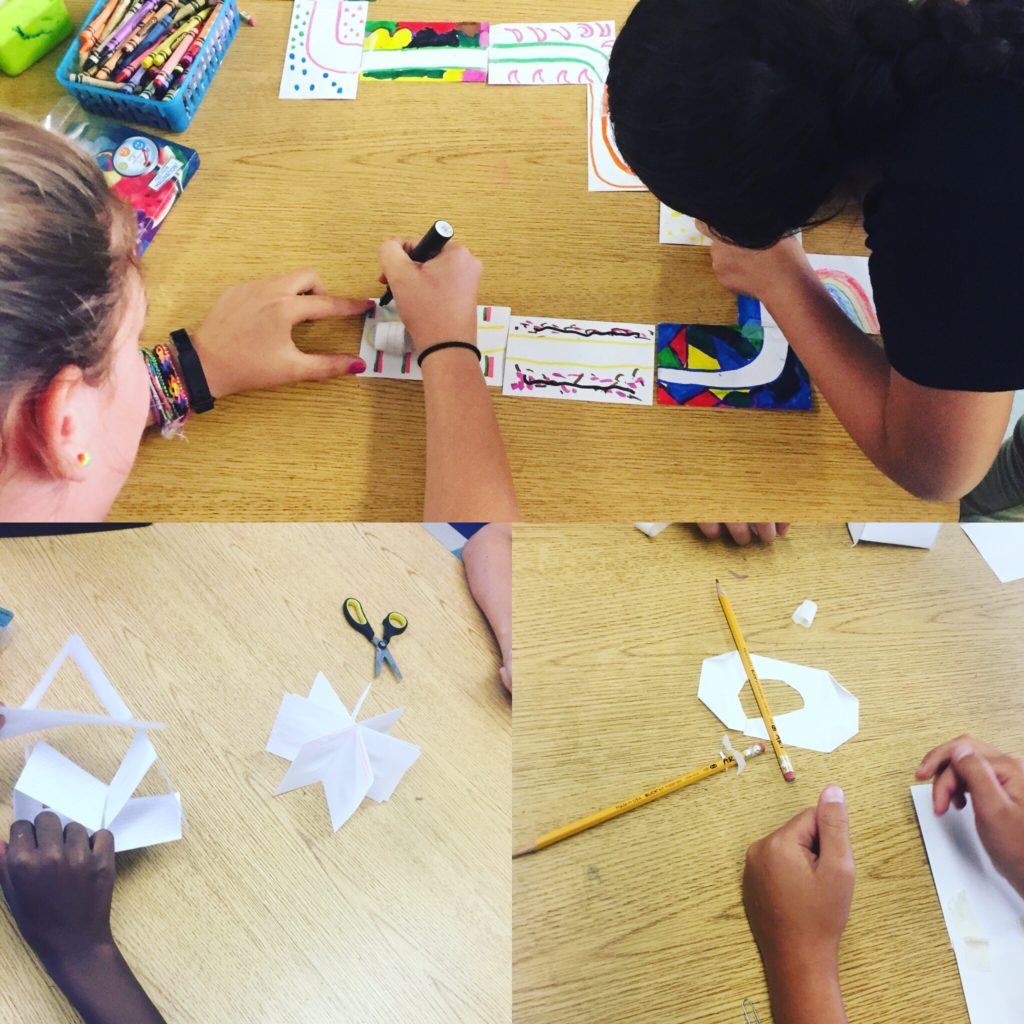
What I love most is that the design challenge format flips the traditional art room modus operandi on it’s head. Instead of coming to art and embarking on a personal journey of completing project objectives, I design my challenges to get kids up out of their seat and collaborating. Disclaimer: A successful design challenge may result in a room that’s louder and messier than normal! It also requires a fair share of masking tape. But for most design challenges, all you need are some recycled materials which is great for ye old budget and a boatload of fun.
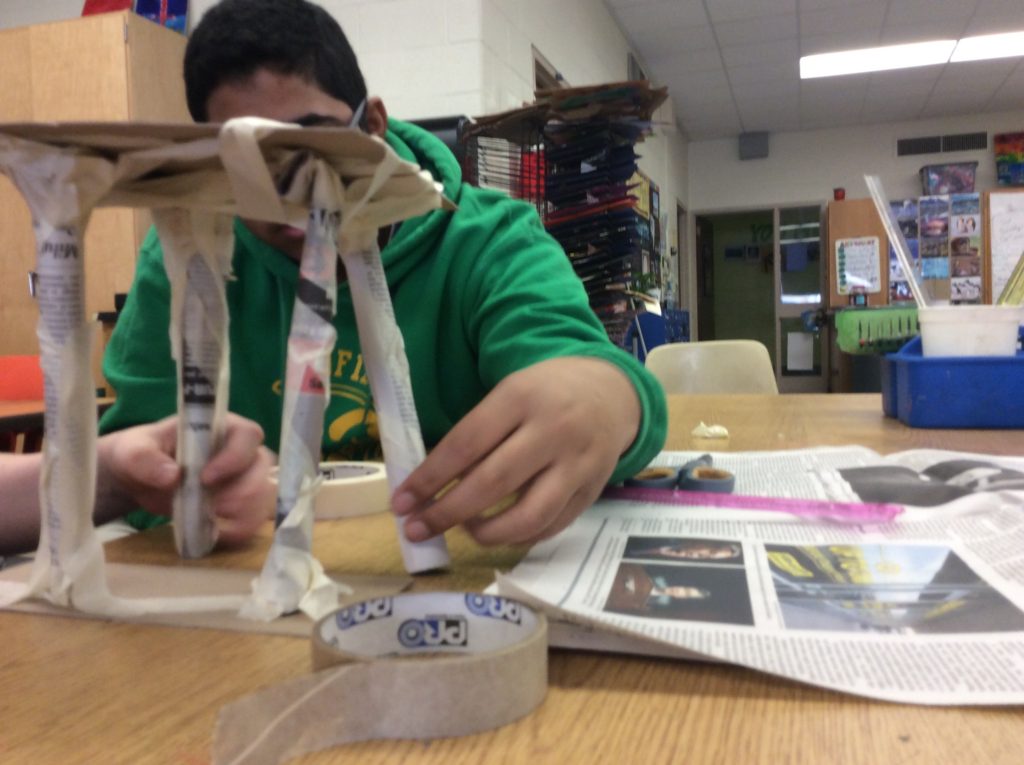
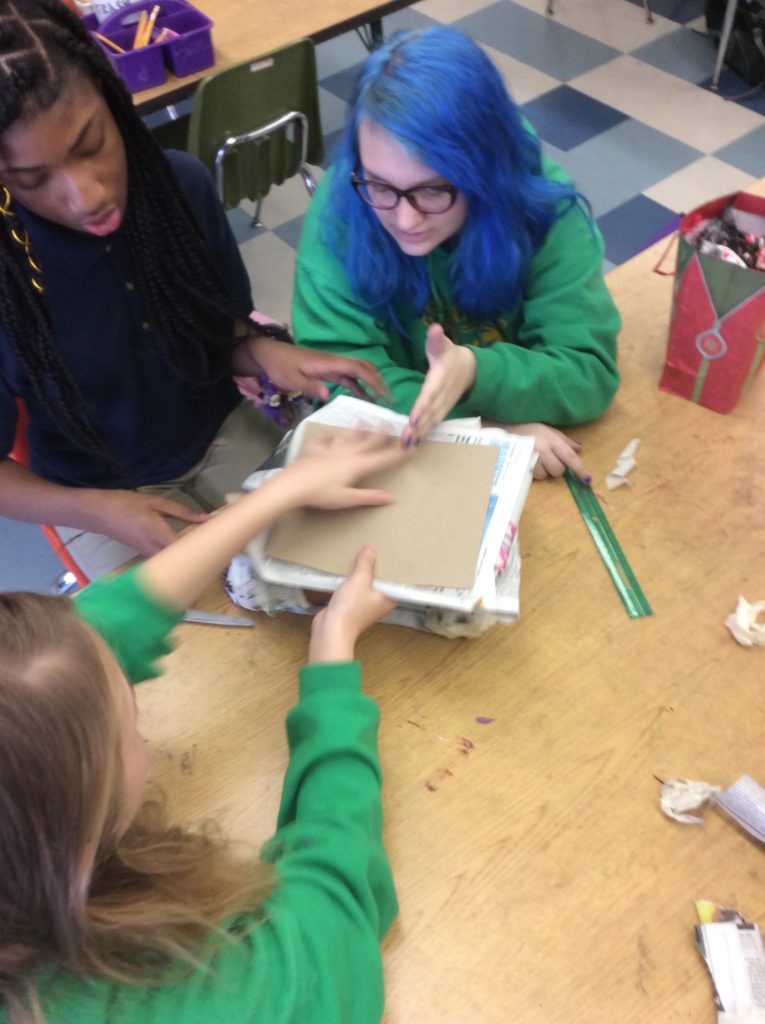
I try to announce the prompt, material guidelines, and rules in less than one minute (time is of the essence!) and I make sure to provide a visual of all the parameters on the board for those that have any questions. And then boom, it’s on your mark, get set, let’s go!
Below is a list to my go-to art design challenges:
· Build a shoe out of newspaper!
· Build a table out of recycled materials that can support the weight of a dictionary.
· Create a kinetic sculpture out of 20 blank index cards.
· Create the longest line you can using only three sheets of paper and tape.
· Create a hat you would wear if you were a style icon.
· Work as a team to use each material in the “Mystery Bag” at your table to create one, complete masterpiece!
· Marshmallow Spaghetti Challenge: Using only tape and 20 piece of spaghetti, build a sculpture that support the weight of a marshmallow.
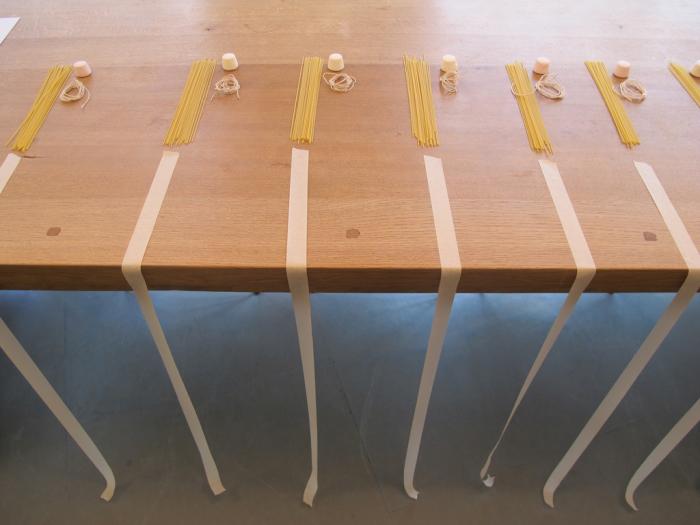
Kiddos usually get 20 minutes to complete each challenge. this chance to work as a team encourages peer to peer dialogue. Kids are forced to negotiate group troubleshooting and solve problems together on the spot. These kind of artistic endeavors help them build social skills in a low-stakes, fun oriented environment.
My favorite part of each day is the big reveal and the debrief! It’s important at the end of each design challenge to take a moment and let the students observe the way other teams solved the problem. There are so many gorgeous moments of delight and exclamations of reverie.
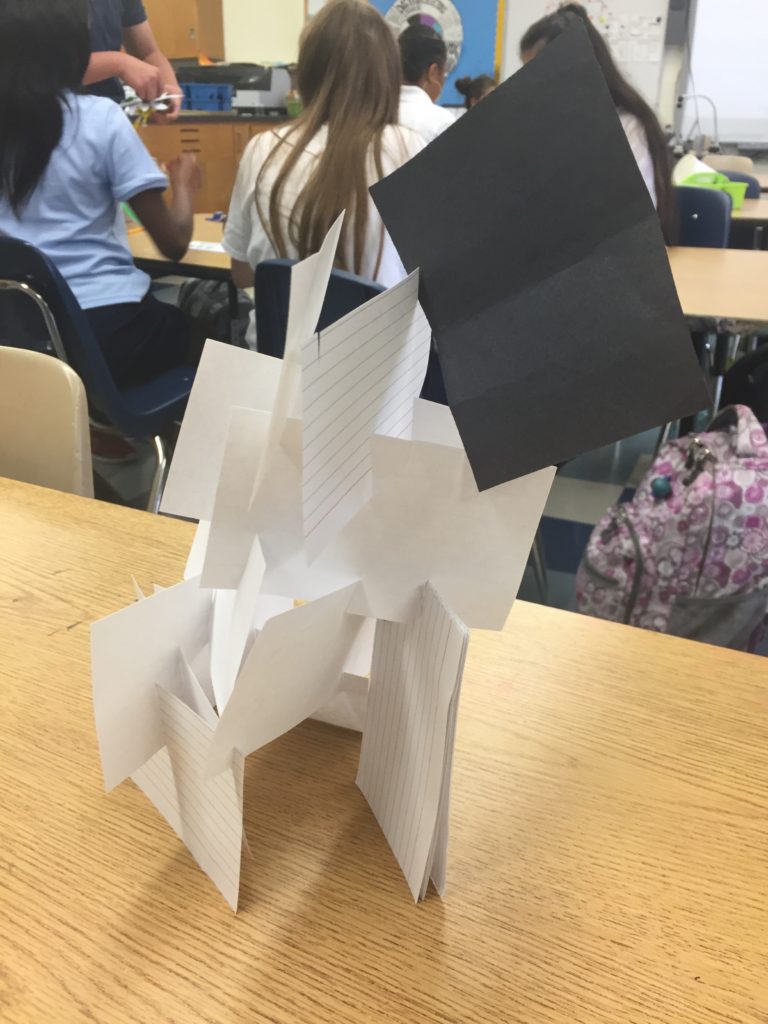
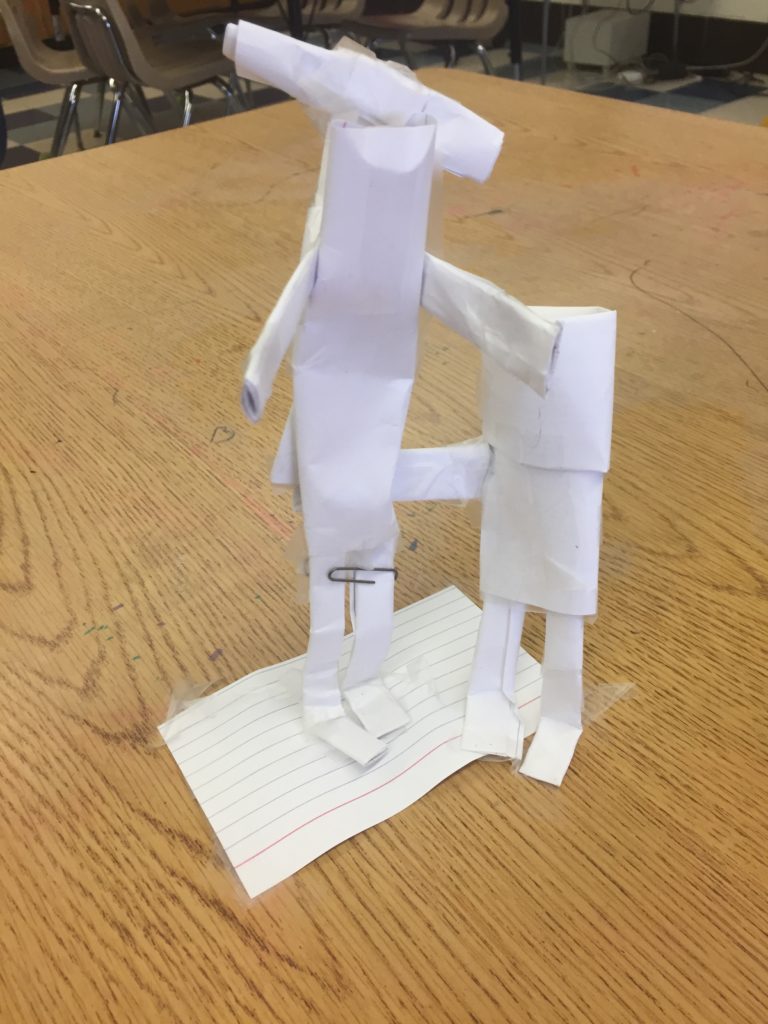
To prompt reflection-related dialogue, I usually wrap up with three simple questions:
· What was the easiest part of this challenge?
· What challenges did you encounter? How did you solve these?
· How did you break up the job with your teammates?
My students have come to expect four design team challenges each year. I like to throw them in on half days when classes are condensed to 30 minutes. I keep the stakes low, no one is voted off the island and no one is asked to pack their knives and go. Sometimes there are obvious “winners” and sometimes none of the teams complete the challenge prompt completely. Both results are okay. If I did a good job as a teacher, my students walk away knowing the joy of just engaging in the design process.
Balancing the Teacher and Artist in Me, By Jackie Thomas
Balancing the Teacher and Artist in Me
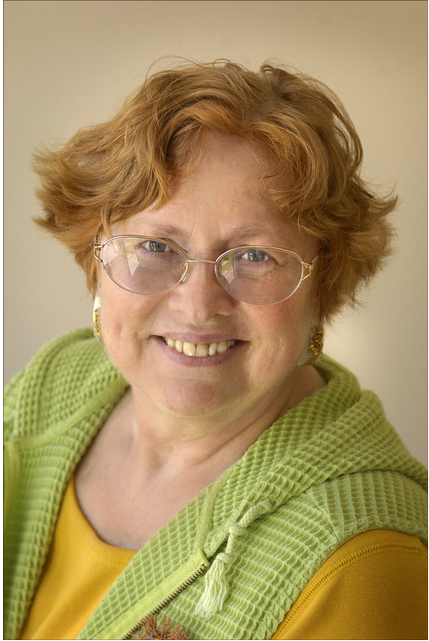
As a Fibers Artist, time has always been a challenge for me. Just plain living takes so much time, and when a teaching career is added, there is little left for the creative process and studio work. I thought I was not really productive in the studio while I was going through challenges of balancing home and school. But in retrospect, I realize I really was productive by channeling my creative energies in a number of ways:
As a brand new teacher, fresh out of college, and having already decided to specialize in Fibers. I packed up a project bag with a pre-woven rya rug backing (on which I drew a simple design), some yarns, a measuring tool, and a large tapestry needle. I kept the bag at school, available for the snippets of time available to work on the rya rug during faculty meetings and in the faculty room (I was told that teachers thought I was stuck up if I never left my classroom, so I scheduled a couple of periods a week to talk with teachers in the faculty room and did my planning at 5:30 in the morning and at home). It was a bulky bag that I lugged around, but I learned about trying to fit into the building and being a member of the larger school community. I believe it took all year to finish that Rya Rug.
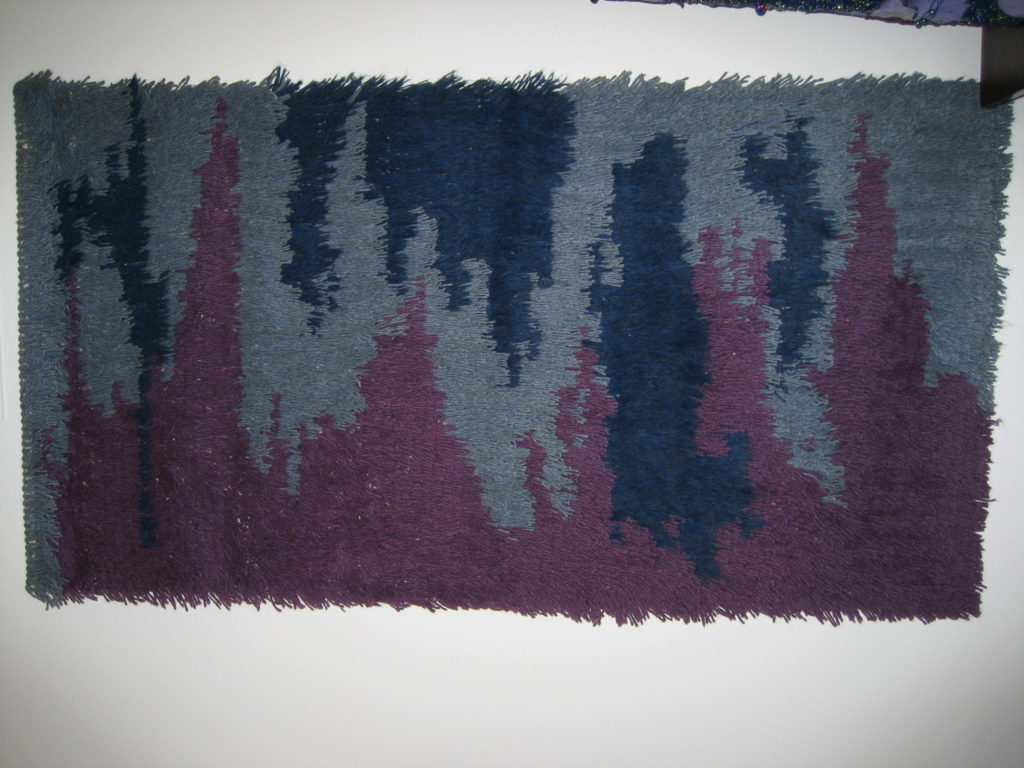
Time to balance teaching and art making didn’t shift any over the years, and I decided that I wanted to complete more than just one artifact in a school year. I looked for projects that would not require much of an investment in time. I tried jewelry making for a couple of years. A new bag of materials accompanied me to meetings and on car trips when someone else was driving.
Feltmaking jewelry:
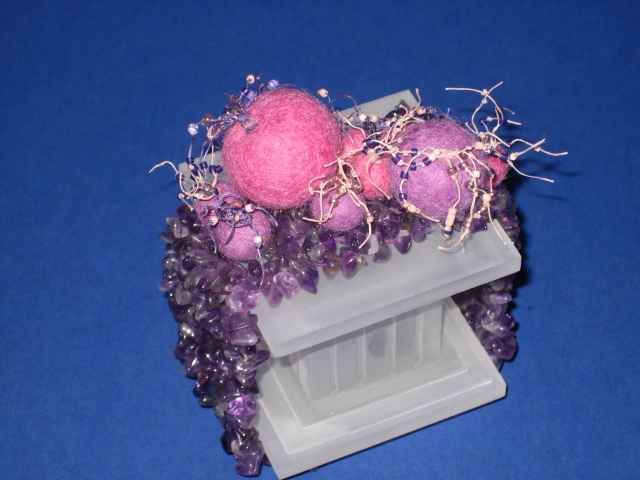
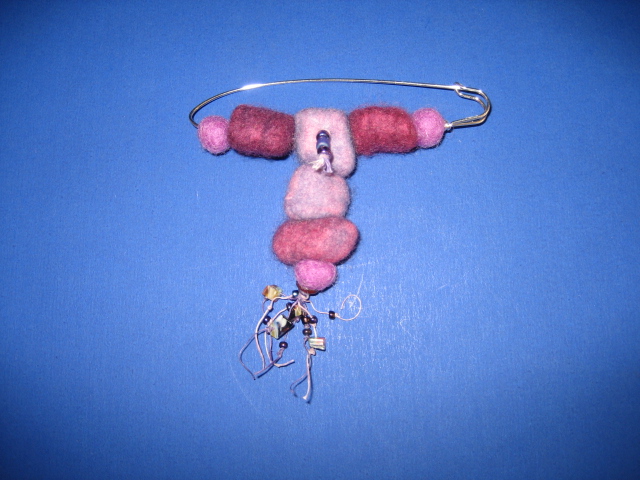
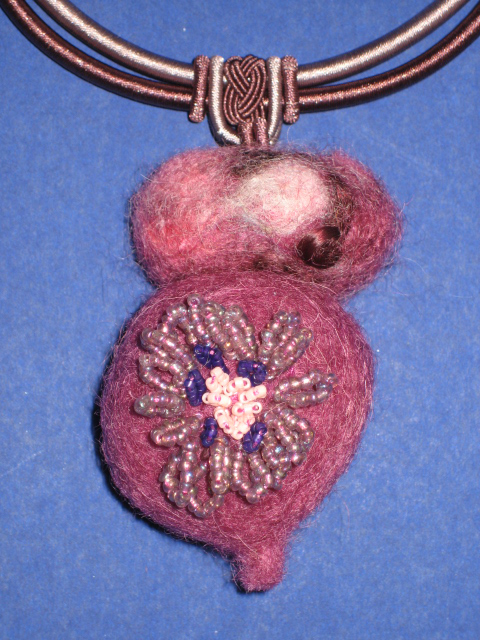
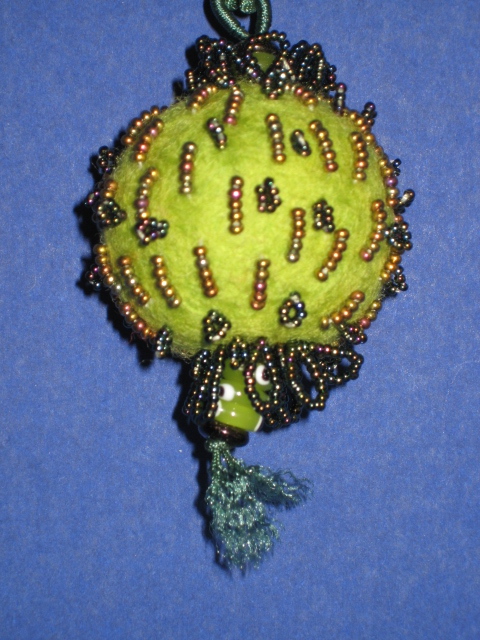
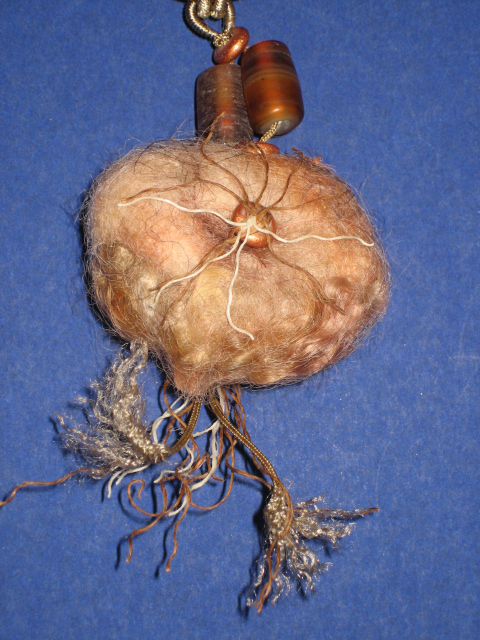
Waxed linen coiling/twining jewelry:
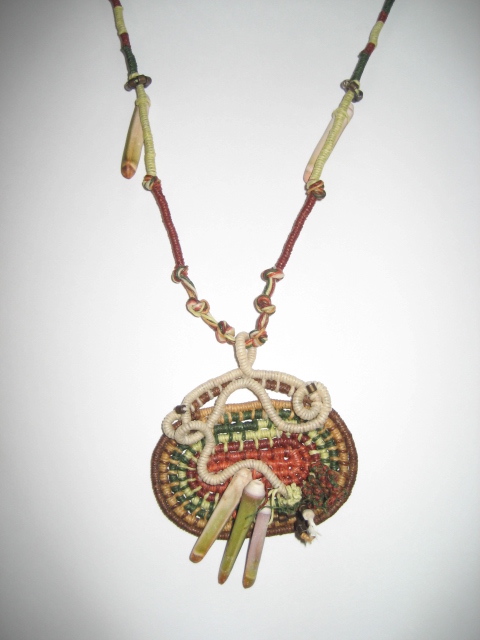
But I eventually decided I didn’t really find jewelry satisfying – too much assembly. And, fibers jewelry making was not really transferable and informative to teaching my students.
Quite by accident I began to make miniature dolls as fetishes and found that quite satisfying for more than ten years. My sister and I attended the American Crafts Council Baltimore Winter Market every year, and I bought one tiny wearable fetish animal doll from An African doll maker each year.
African Animal Fetishes:
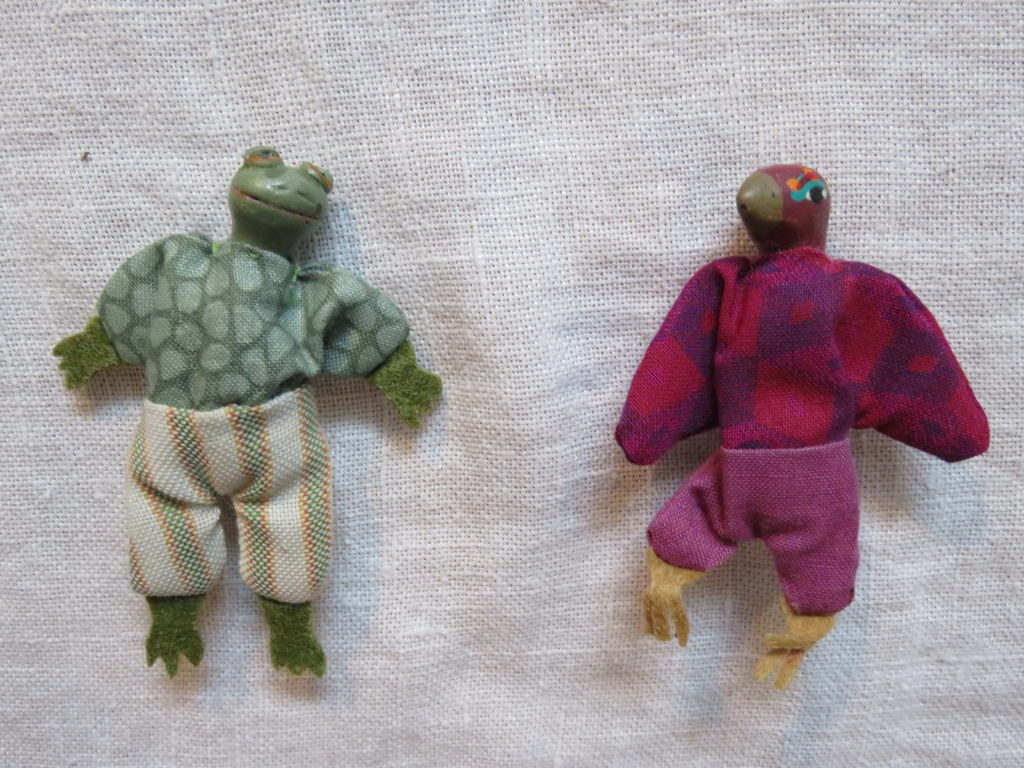
“A fetish is an object of magical powers. It is a guardian chosen by you. Once you have chosen your fetish you must promise to faithfully care for it. You must keep it in a warm, dry place and feed it one grain of corn or rice or bean each year. In return, it will insure you good health, clear sight, protection against injury, success in hunting and trading, and abundant love.”
After the fetish artist moved back to Africa, I went through fetish withdrawal, and I began to design and make my own little fetish dolls. I have worn a fetish every day over the past 40+ years.
I usually worked on a series of fetishes of one color/fabric but each with it’s own look/design (one to keep and the others to share). I tried to complete one step in each sitting (i.e. trace the pattern onto the cloth and cut them out; sew the fetish shape with right sides of the cloth together & leaving an opening along one leg; turn the cloth fetishes right side out, stuff them and stitching them closed; embroider the faces; add hair; clothe one fetish at a time).
Some of my Fetishes:
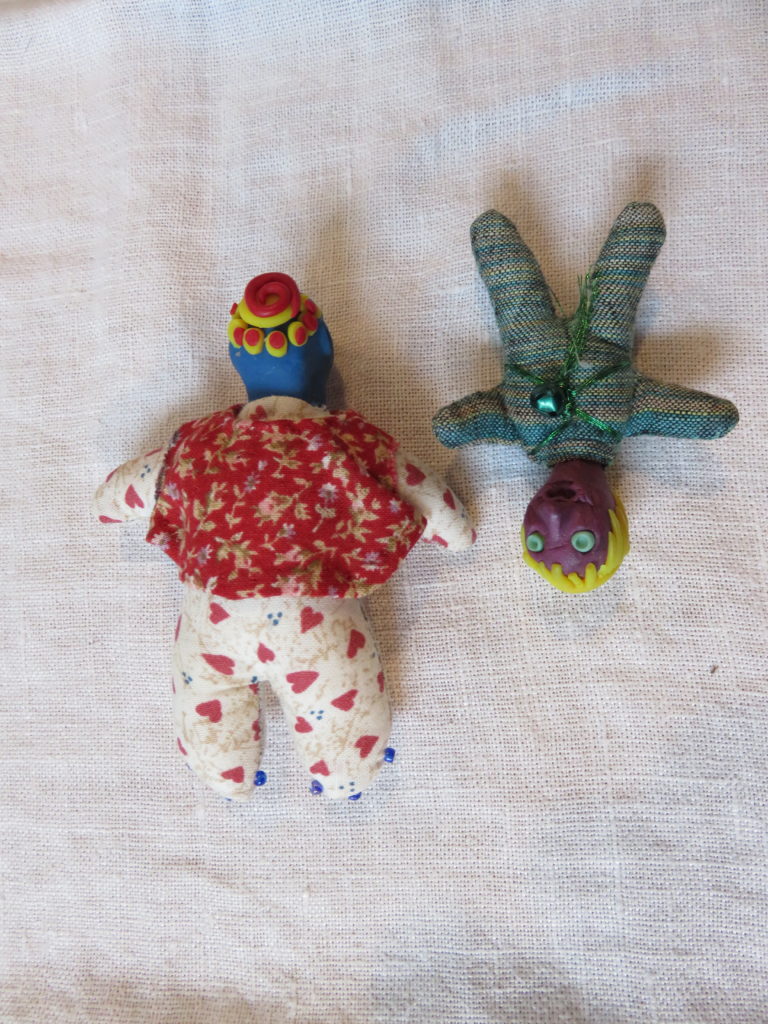
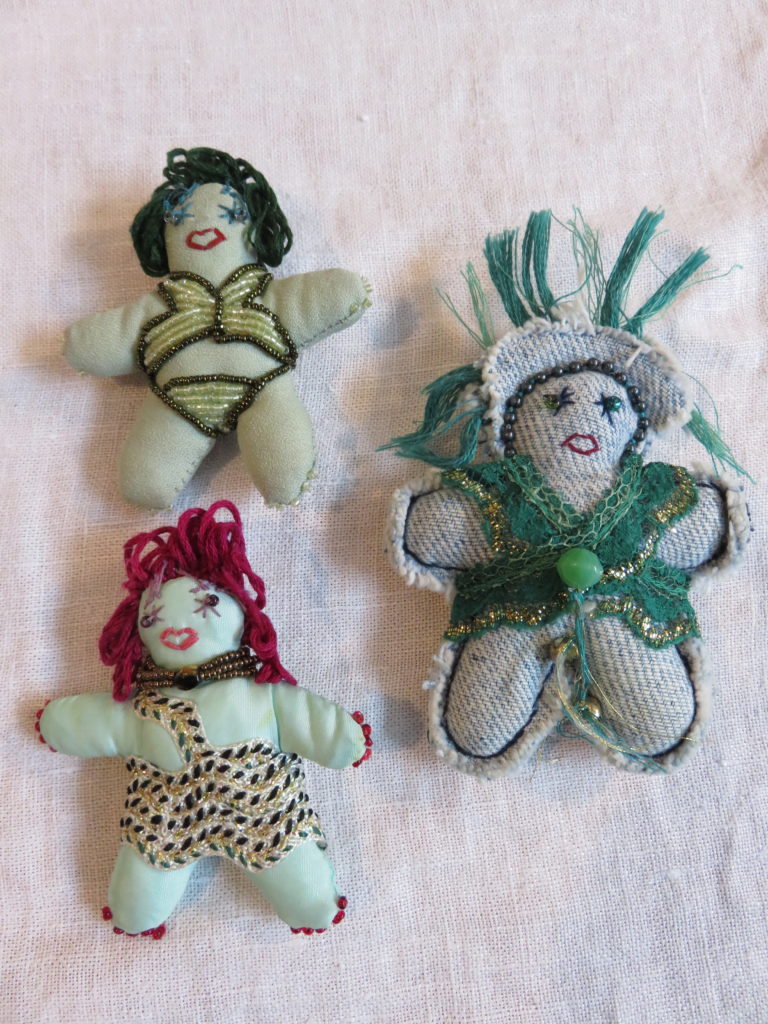
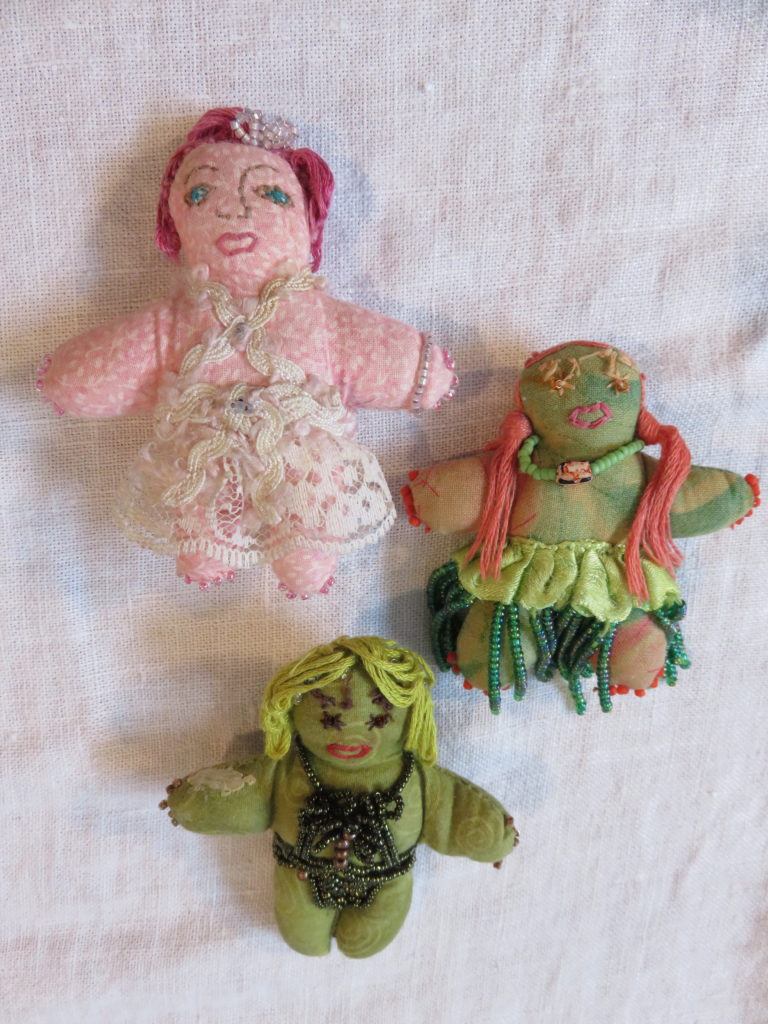
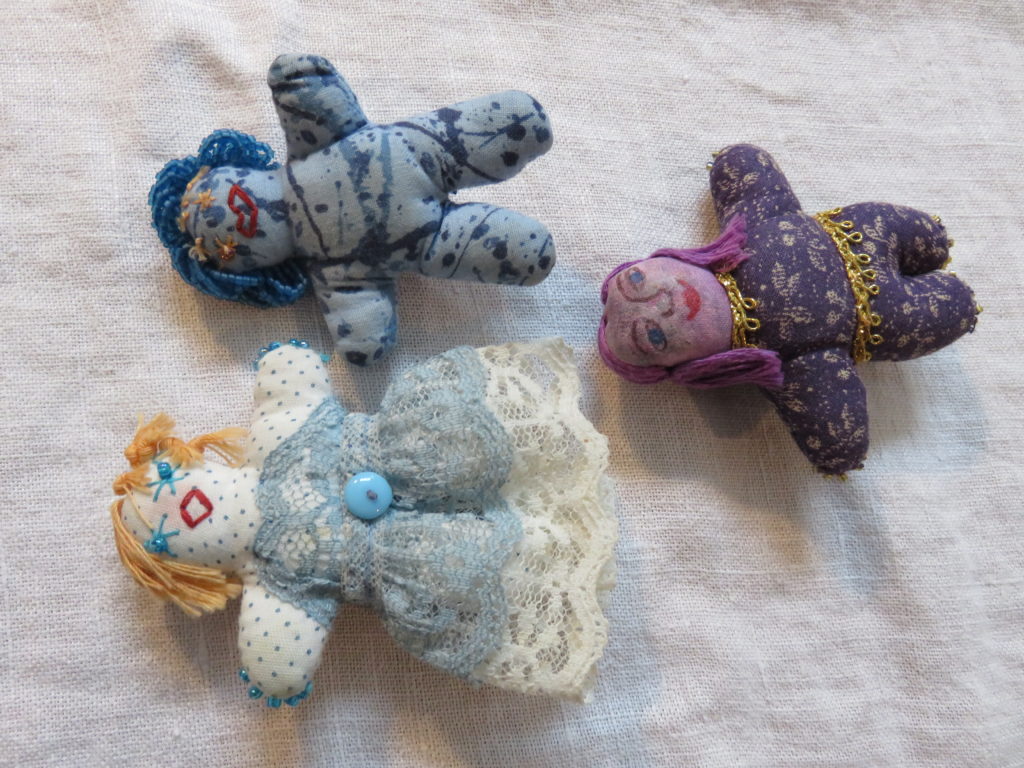
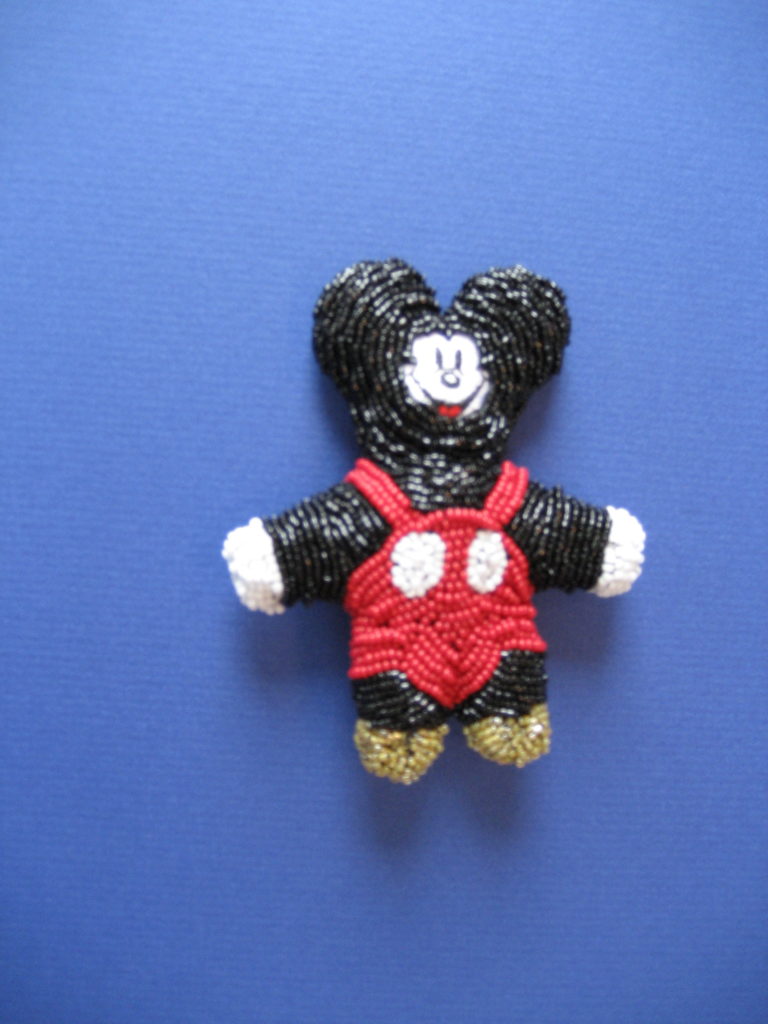
An AHA! Moment occurred when I realized I had boxes and bags of process and project samples for feltmaking (and other fibers processes). They were already of my own hand and design. I pulled them out and began to assemble them into larger sculptures (a technique I then used with students as well). I also challenged myself to create one-a day miniature artifacts to be assembled later into larger pieces.
“Pulls”
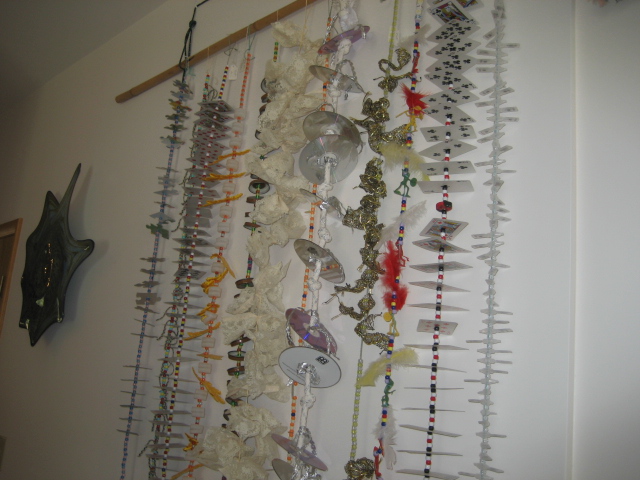
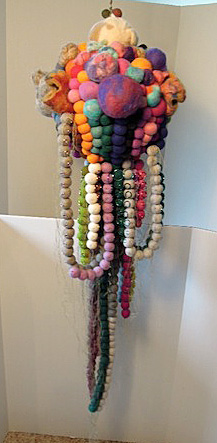
“It’s An Octopus!”
The challenge is the time. I dedicate time (usually weekend or evening) to get a project concept defined in my sketchbook and to organize materials. I look at my schedule to see where I might capture unscheduled time. And I always have a bag or a box loaded and ready when time suddenly and unexpectedly becomes available. I have rules:
- Never let my own art work interfere with planning for my classes and experimenting with materials and techniques before teaching them. Planning is important.
- Never work on my own art during teaching time.
- Request someone else drive whenever possible so I can work on a project during the trip.
- Always have a journal or paper to write down ideas, things to remember, and to record discoveries and things I learned.
- Collect materials and experiences on every walk, vacation, and opportunity.
- Never throw away project failures or demonstration projects. They may serve another purpose later. At the very least, failures help me remember how NOT to do it (because otherwise I will usually do it the unsuccessful way over and over again).
- Teaching others is a prime way to learn and improve my own skills.
- There is always something to be learned, even in the most repetitive experience.
- ALWAYS be ready to work on a project…. i.e. ball gown components created while sitting at Little League games.
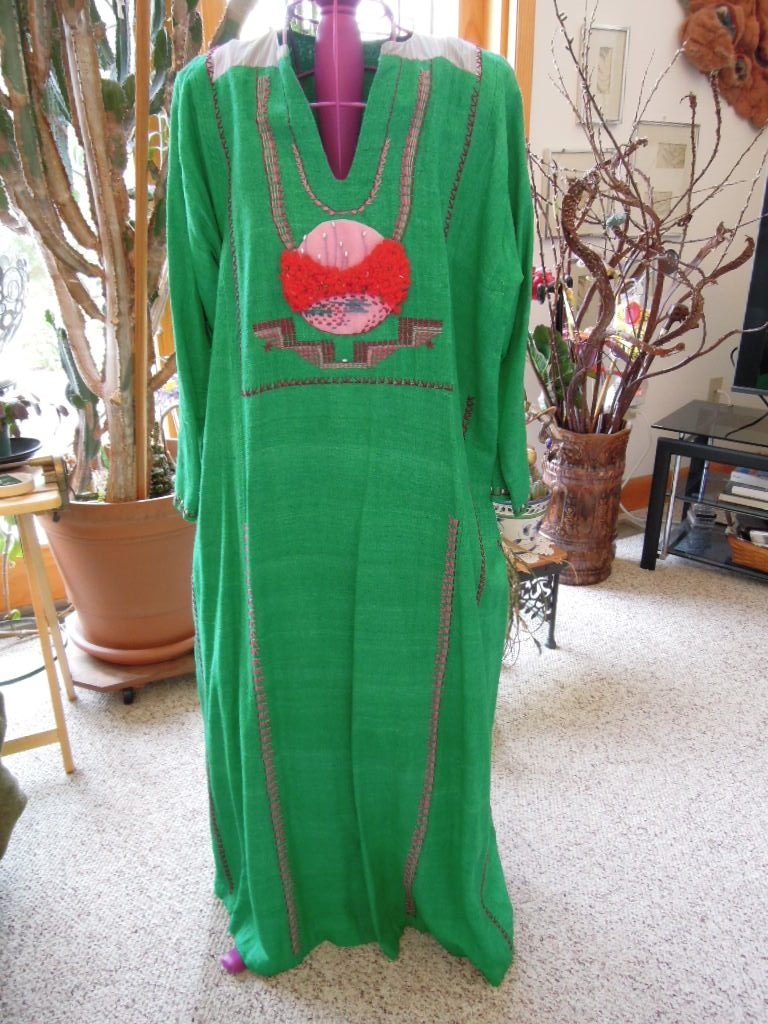
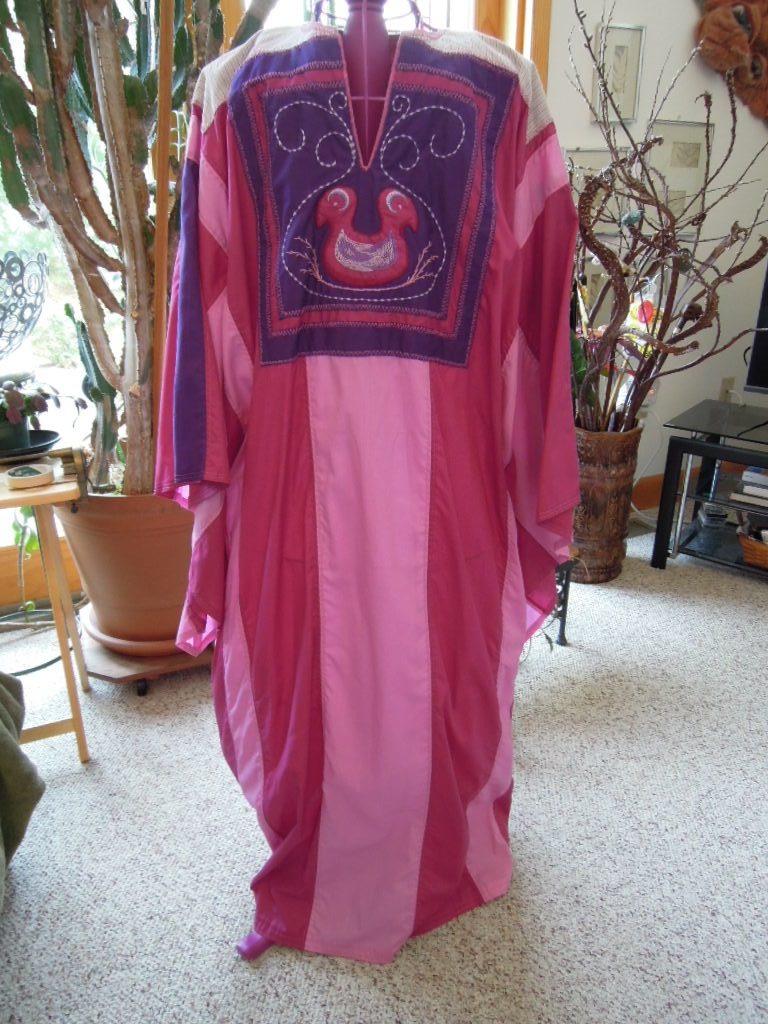
If nothing else inspires, I can always redesign/embellish wearables from my closet.!

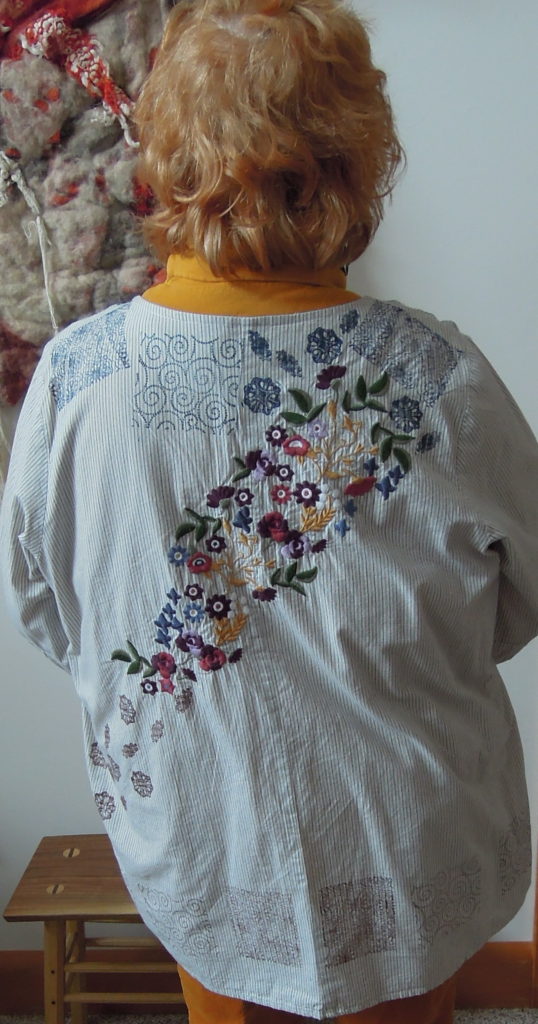
C’est Finis!
PAEA AWARDS – EVERYTHING YOU WANTED TO KNOW BUT WERE TOO AFRAID TO ASK!
Marcy Bogdanich is the PAEA Awards Chair for the Committee, and has loads of helpful information to share about the process.
Awards not only recognize outstanding art educators across our state but act as an advocacy tool for continuing to keep vibrant art programs in Pennsylvania.
THE BASICS!
Send all of the following in ONE folder to paeaawardschair@gmail.com on or before the deadline of Tuesday April 30, 2019. Submissions, complete or incomplete, will not be accepted after the deadline. Missing items will not be considered.
1. 2019 completed NAEA Awards Program Nomination Form and Standardized Vita.
(these can be found at www.arteducators.org/awards)
2. One nomination letter written by the nominator.
(nomination letters MUST be written by a PAEA/NEAE member)
3. Two additional letters of recommendation
(letters supporting the nominee may be written by a PAEA/NAEA member or non-member)
4. A one-paragraph biography of the nominee
5. A high resolution digital photograph
Rubrics will be used for judging all regional and national awards.
Rubrics found on the PAEA web site and at www.arteducators.org/awards will be used for reviewing the nominations submitted for all NAEA awards.For regional and national awards, rubrics have been created to recognize the differentiation in roles among divisions, with separate rubrics for Higher Education, Museum, Supervision/Administration and Preservice and a combined rubric for Elementary, Middle and Secondary.
There is no rubric for New Professional but a very detailed list of criteria is required. All documents need to be submitted together.
ADDITIONAL AWARDS INFORMATION
Eligibility – members who currently serve as voting members (elected or appointed) of a state association board are ineligible to be nominated for NAEA regional, divisional or national awards. Immediate family members may not nominate other family members for awards.
NAEA Awards – NAEA Regional Art Educator of the Year and NAEA Regional Divisions Art Educator of the Year can be submitted from any member and validate member/division status. Any member may also nominate his or her self and send the required information directly to NAEA by-passing the PAEA Awards Program. States/Provinces may identify more than one candidate for these awards. NAEA will forward all nominees to the respective national award committee chairs for committee selection of national award winners.
Nomination Letters – Nominators and nominees should be able to craft support letters so that they can be used for both state and national-level nominations. Simply put, in the award category, list Outstanding Elementary Art Educator without the PAEA/NAEA designation.
AND FINALY – The PAEA Awards Chair will be responsible for submitting PAEA award nominations to www.arteducators.org/awards. If you are nominating outside of PAEA, and know that you may self-nominate for any award, you should submit all information at one time to www.arteducators.org/awards by October 1st.
Please do not submit additional materials that are not requested.
Make sure all pasts to the nominating form and vita are filled in on line.
When filling out the Vita it is best if you choose the most currant and important information related to the award title. Over filling the question boxes on the form does not increase chances for an award. In some cases, when clicked on, some boxes do not expand and the viewer is not able to read everything written. If it takes 20 lines to list your current accomplishments go for it! But stuff from 1999 not so much!
WHEW!!!!! Lots of info. Don’t hesitate to contact Marcy for clarification. paeaawardschair@gmail.com
Meditative Art Making by Lisa Marie Ferry
Please enjoy this fabulous post from Region 9 representative, Lisa Marie Ferry
Meditative Art Making
With the hustle and bustle of the holiday season, EVERYONE is stressed out. And as we try to bring the kids in from the excitement of the season, art educators are naturally exhausted. What can we do to reduce this stress and have fun at the same time?
Meditation. Yeah, yeah, Lisa Marie, we know that meditation is great to reduce stress, but how in the world can we do this in the classroom? And what about me? I know you always say, “you need to take care of yourself so you can take care of the kids”. Well, hold on to your paint brushes to learn some techniques that are tried and true (and even some of your colleagues may join in).
So let’s get started with first thing first…
Music soothes the beast, so start with one of the great apps, like Insight Timer, or music on YouTube, like Nora En Pure. The kids say it reminds them of something that would be played in Holister (WIN!)
Stress Relief Meditation Painting:
- No painting skill required (it’s abstract, my fav)
- This technique takes you to a deeper creative process by focusing on the music, nothing else.
- It helps ground you and refocus
- Don’t forget to breathe, deeply
- This process is letting your intuition take the reigns and run with it. Close your eyes and listen to the music for a few minutes, while deep breathing in to the count of 5, then exhale to the count of 8.
Supplies:
- Canvas or canvas board
- Acrylic paint (pick your favorites)
- Pallet knife and paint brushes
- Sponges
- Paper towels (for clean up and to use crumbled up for texture)
- Bubble wrap (because it is fun to dip in paint)
Squirt the paint in small piles on your canvas. Then using the knife or brushes, start swirling around to cover all the white of the base. Try to keep it marble-like (not to over blend).
You can use a hair dryer to speed the drying process or to help move some paint around. Sometimes, you can mix up paint with added water and do some drips, spatter or sprays. Don’t forget about the sponges and bubble wrap for added texture or once it is dry, a contrasting color added on top.
Check in with how you are feeling; are you still doing deep breathing?. Do you feel like time is passing by and your feeling quite relaxed? Then, you are on the right track. If you are feeling bored or tense, change the way you are painting. Use cardboard to scrap the paint across, use more of the sponge to “dab” (yes, I said DAB-lol).
Patterns and Repetition
Meditative Happy Find Rocks:
Dots. Dots are fun and easy so why not make a beautiful piece of work. Plus, the repetitive process is very calming.
Supplies:
- Q-tips
- Toothpicks
- Pencils with new erasers
- Or anything you can make a smallish dot with, like your pinky tip
- Acrylic paint
- Paper, canvas, river rocks (yes, my fav because you will see below)
Mix up your classroom, before you start, offer hibiscus tea to the students, sit in a comfortable yoga position. Play a river soundtrack on YouTube or Insight Timer. While they are sipping their tea, discuss this next project. Talk about pattern, repetition, and color. Also, look at mandalas and have the students understand about circular repetition. Either pre-find the river rocks or any other smooth rock, or take the students on an exploration outside when the weather is nicer.
Start in the center of the rock and make your way around with circles of dots. The best part is that you can have the students trade the rocks like ATC or have the students hide the rocks around the school and grounds for someone to happily find it to make their day.
Don’t forget to all come back and reflect the project and how it made them feel. Of course, don’t forget to sip your tea in a comfortable yoga sitting position. See how it all comes back around?
The most important thing you have to remember with any meditative/stress reducing project is to BREATHE, Taking deep breaths throughout you day help to ground and refocus so you can clearly enter your next challenge that pops up with a clear head. When life seems too overwhelming, name 5 things you can see, 4 things you can touch, 3 things you can hear, 2 things you can smell, and 1 thing you can taste to help ground your thoughts and clear your head, so you, and your kids can be in the present moment and CREATE!





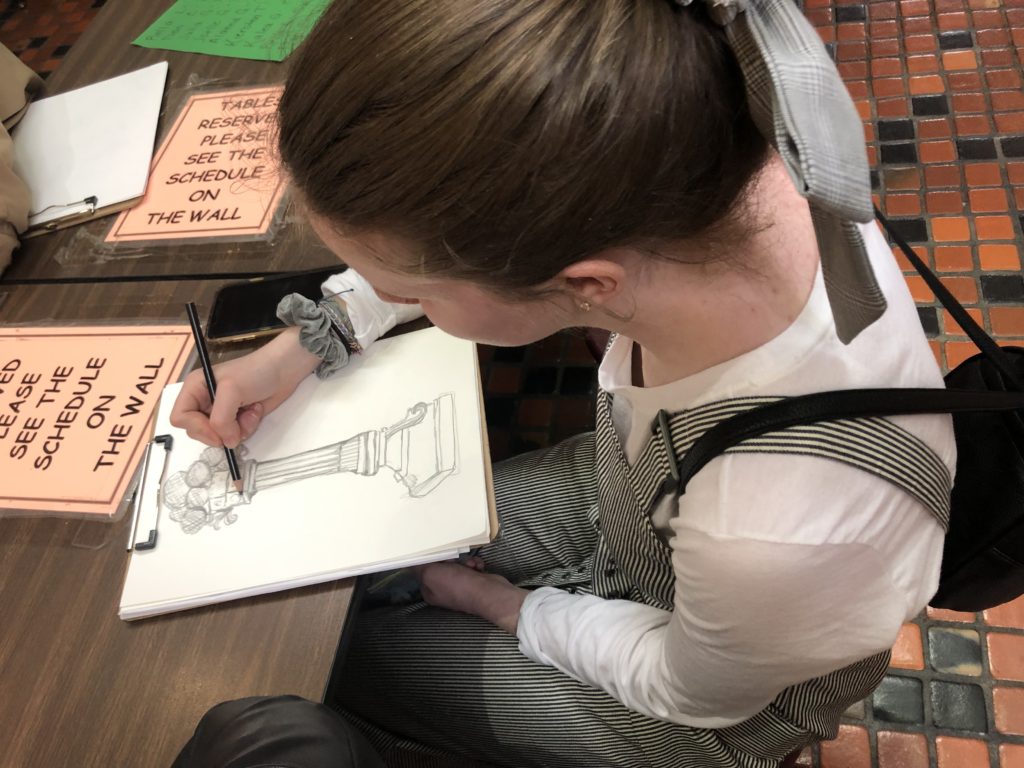
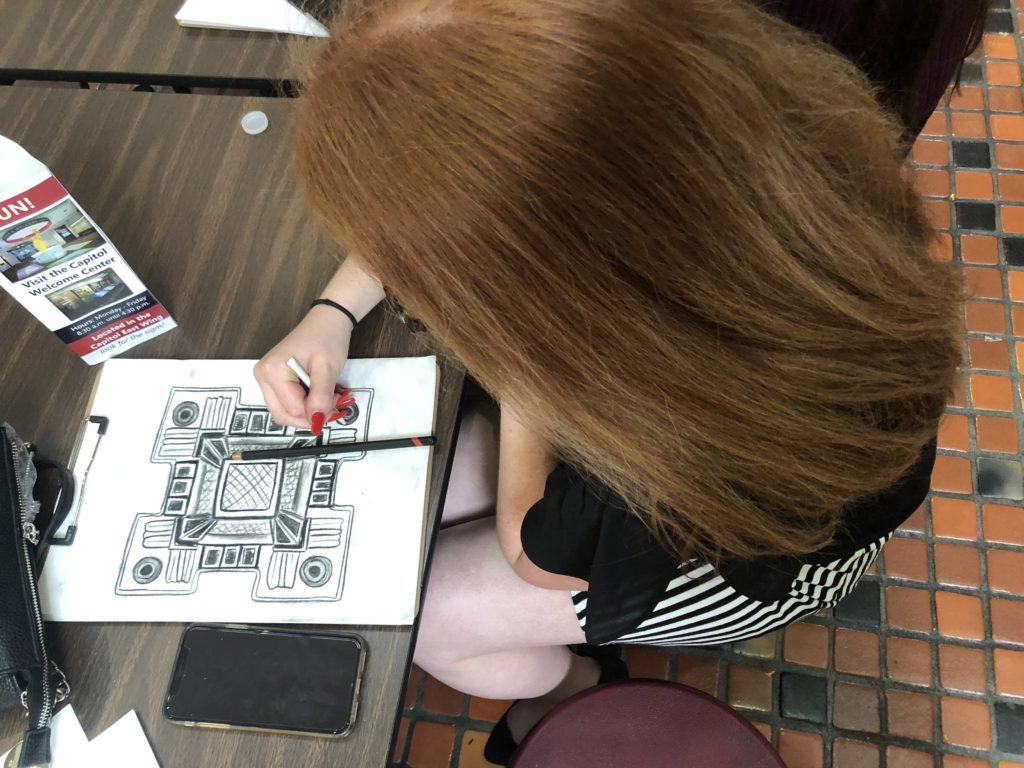
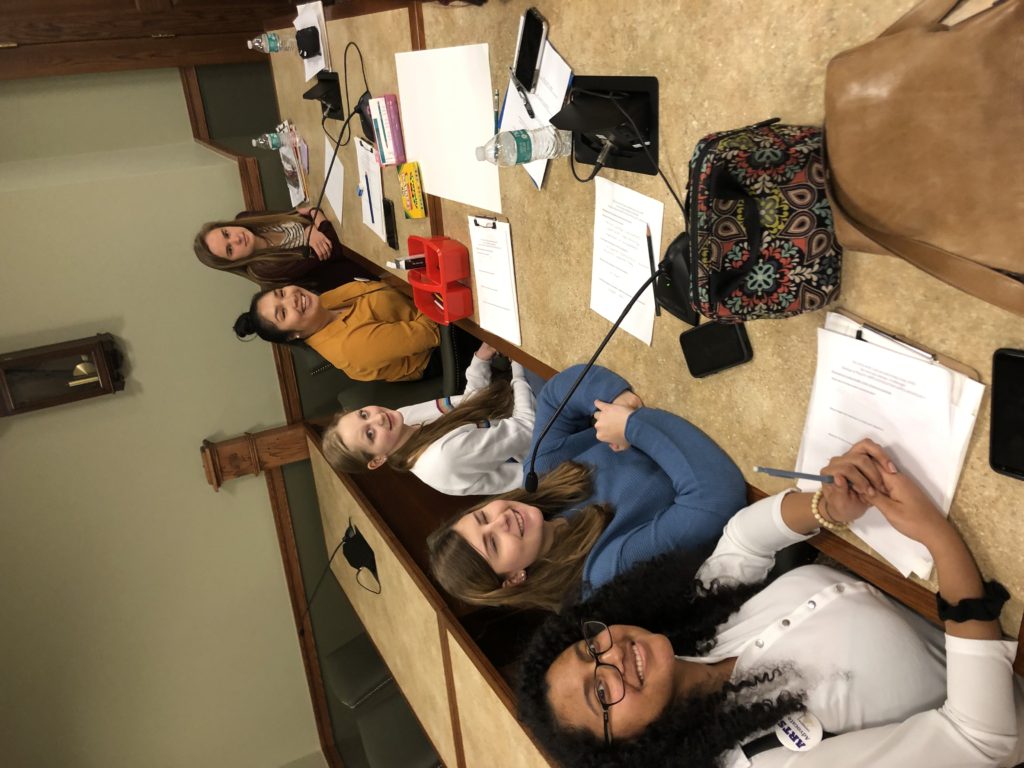
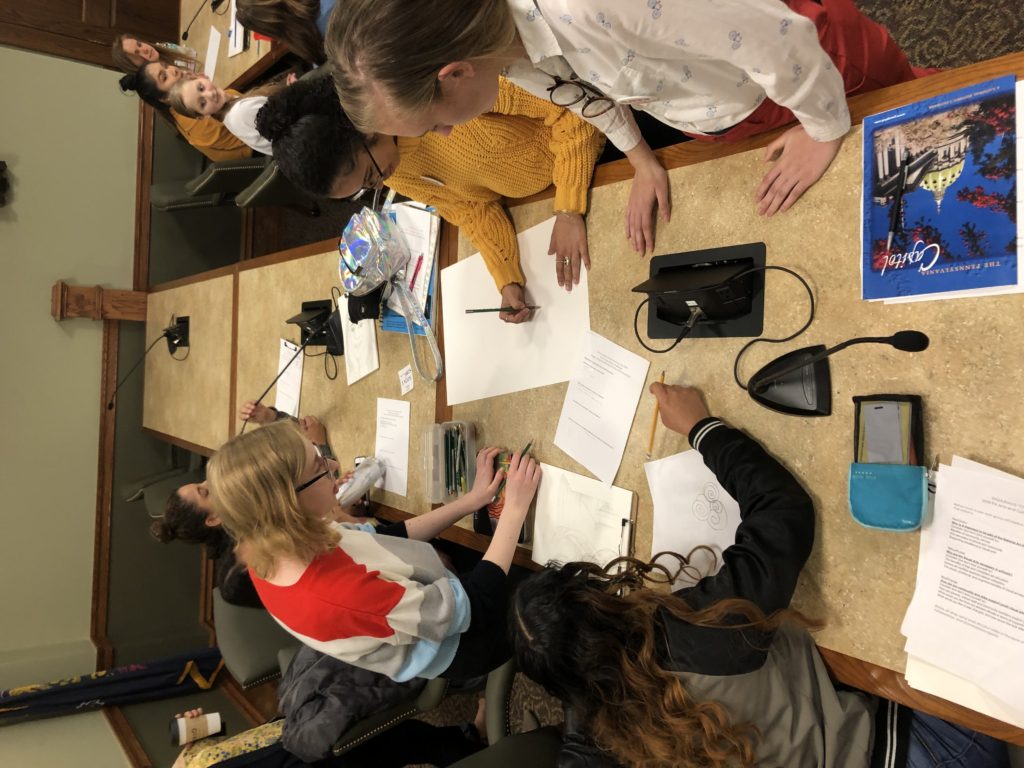
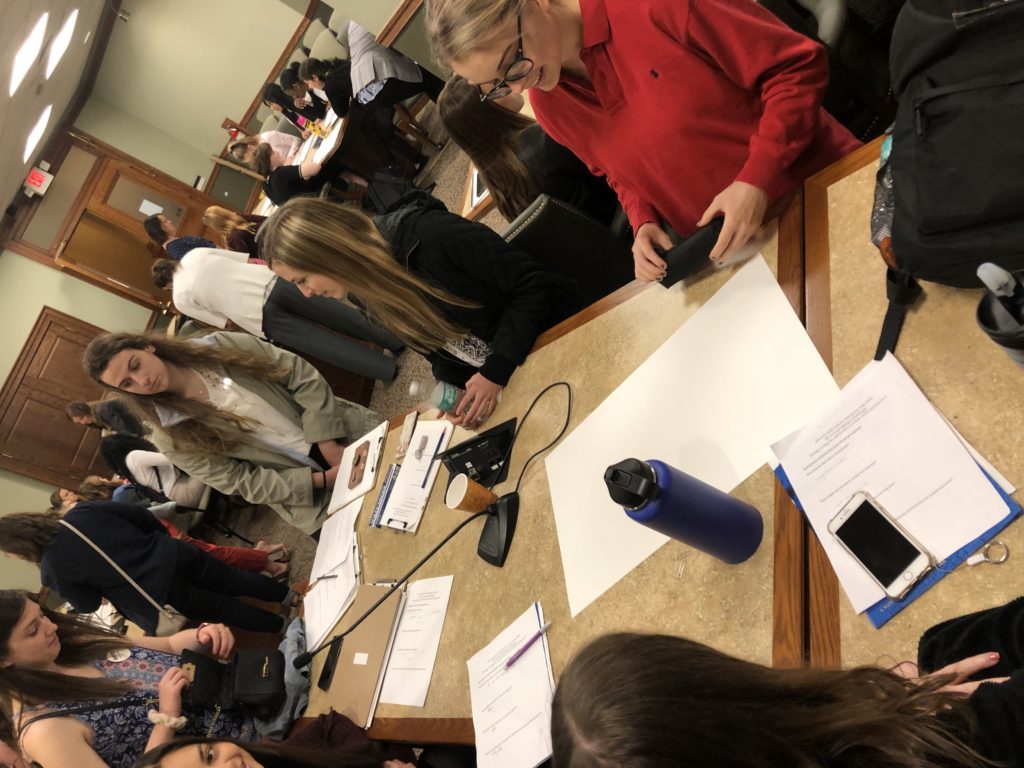
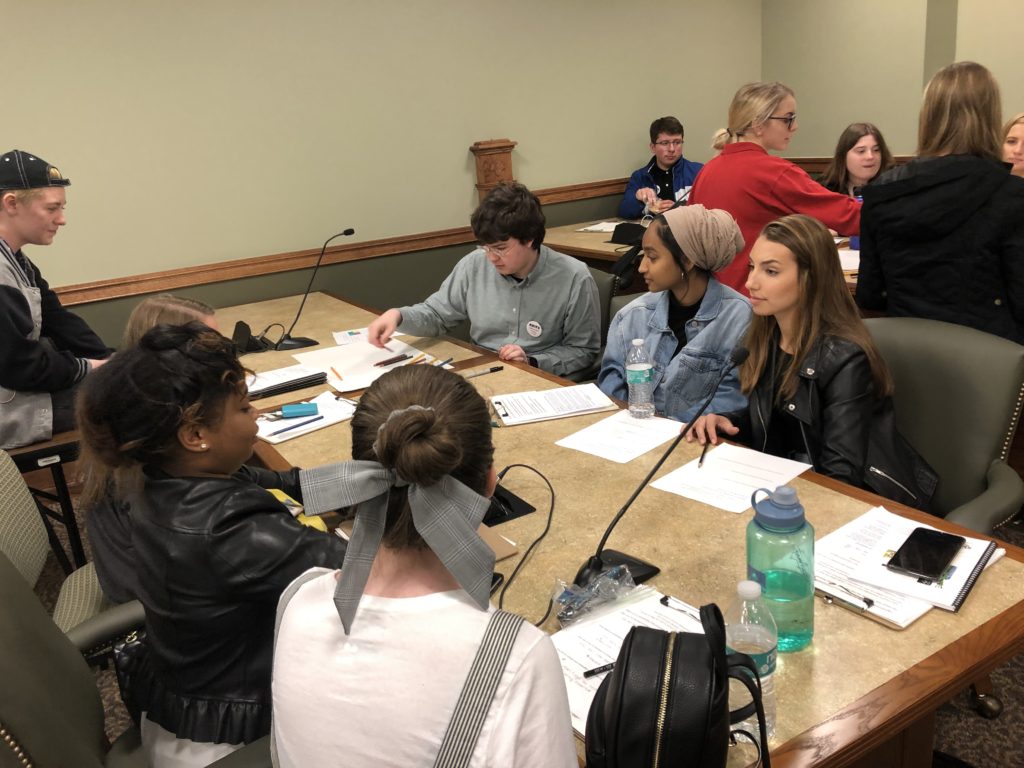
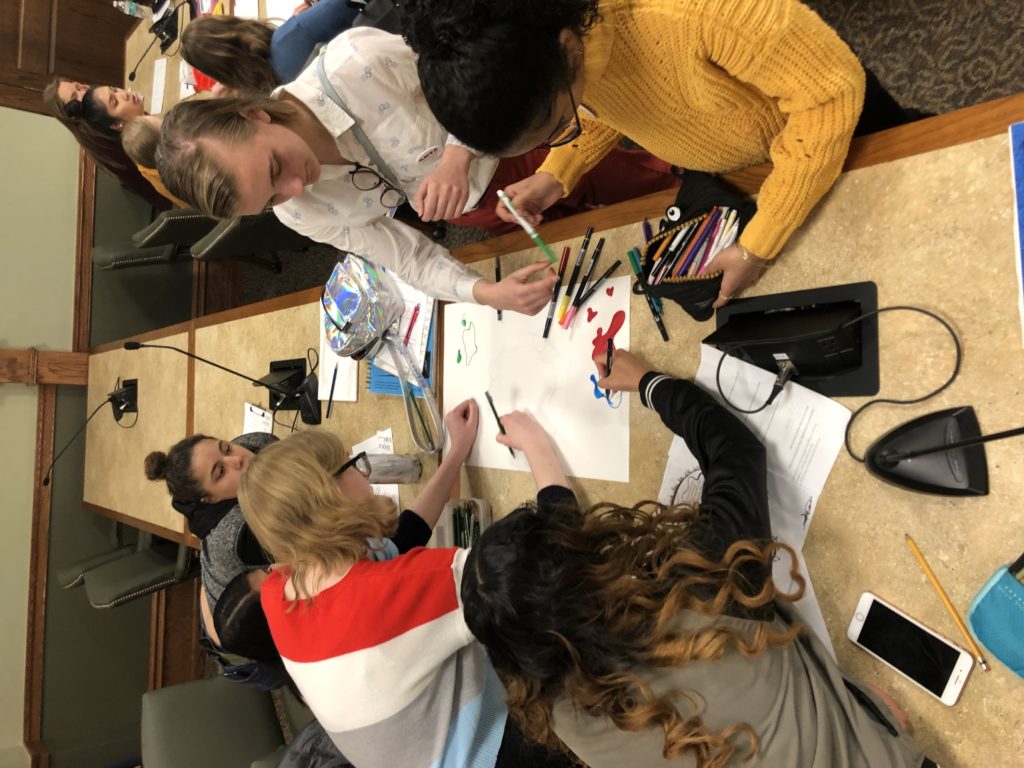
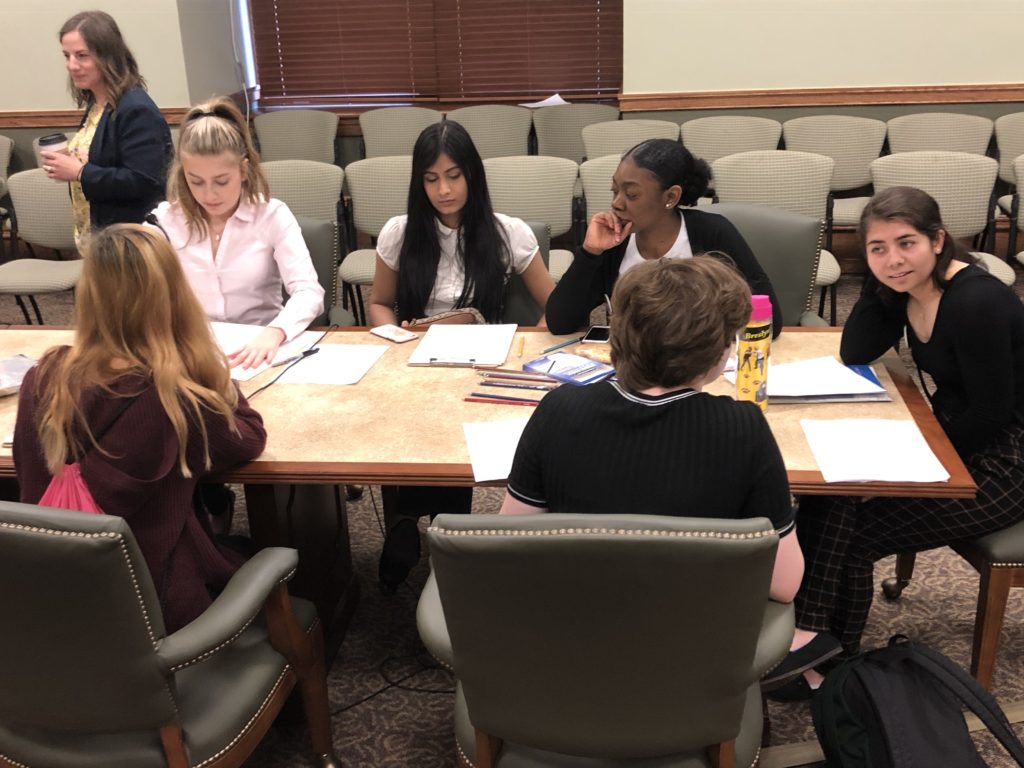
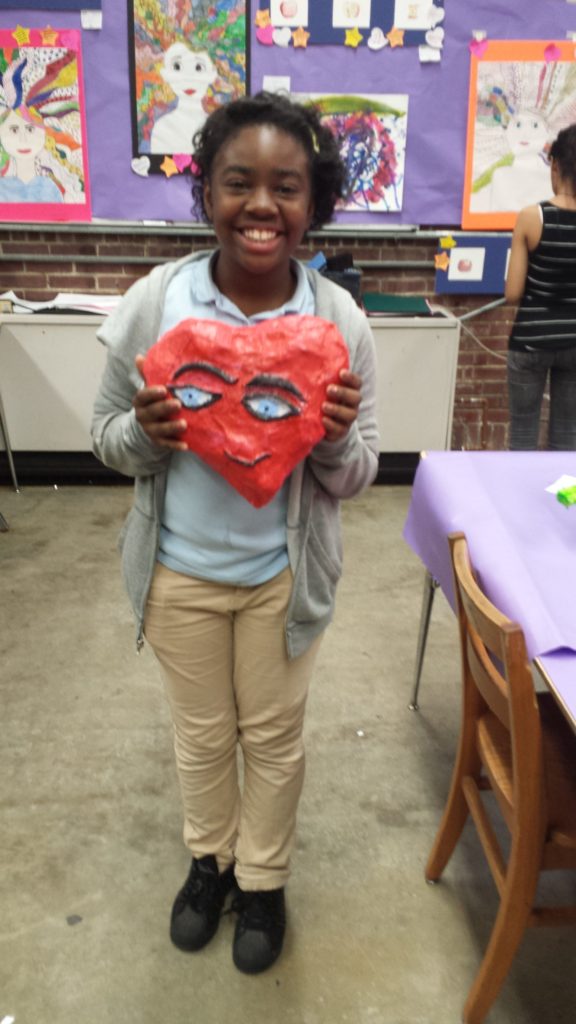
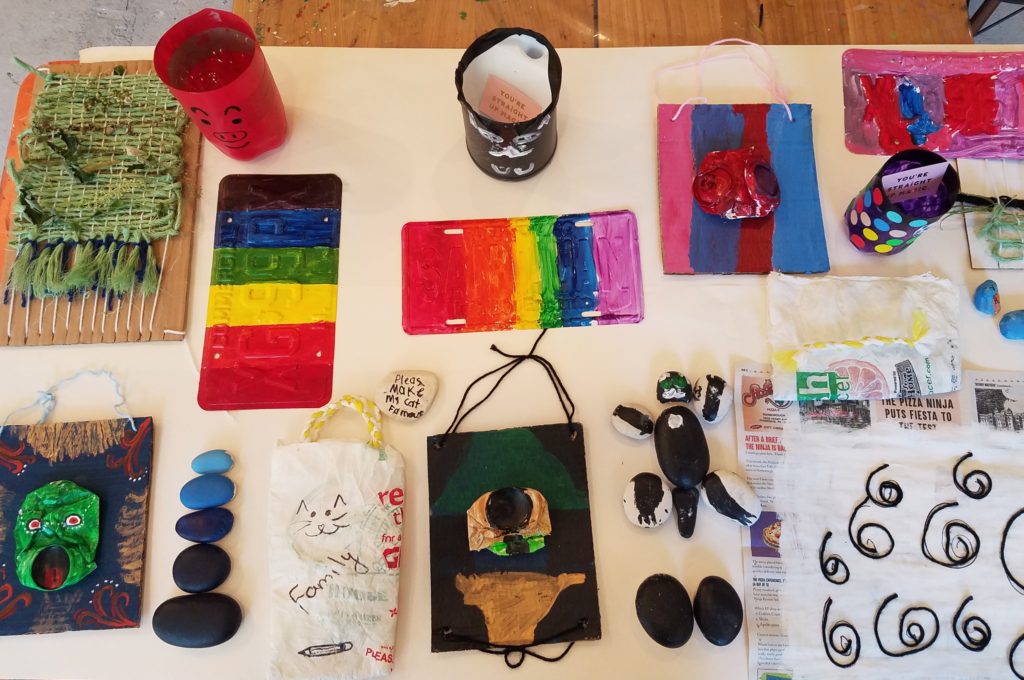
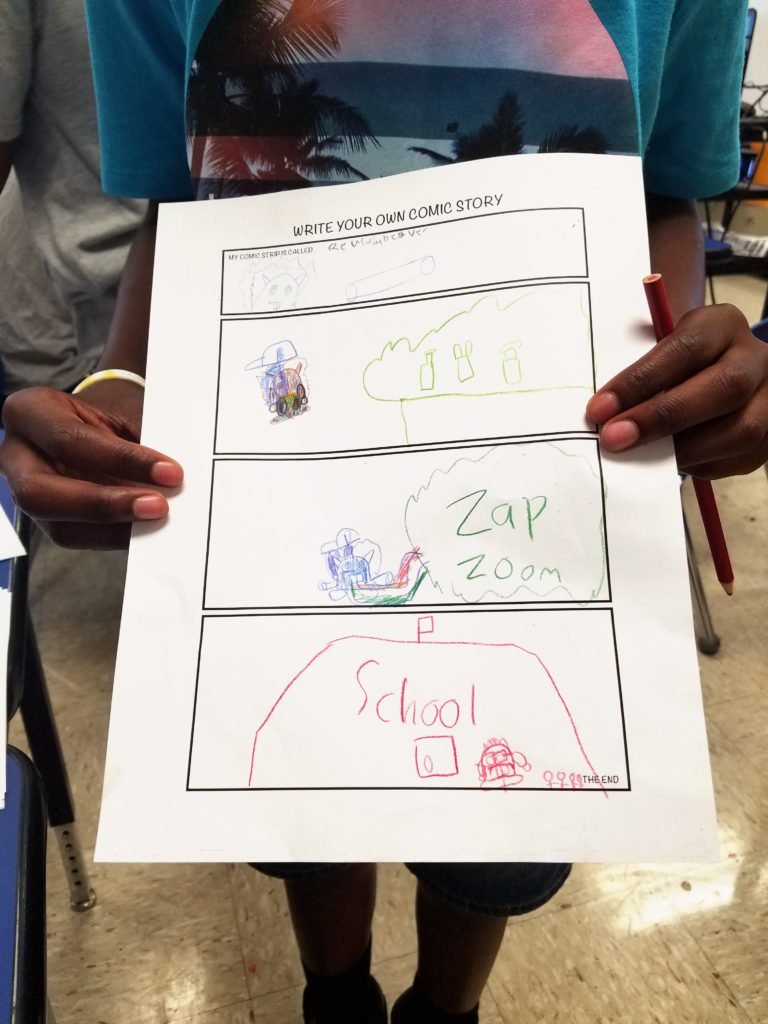
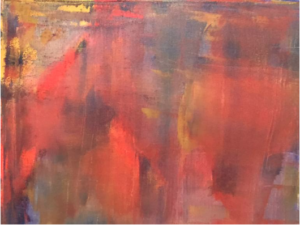
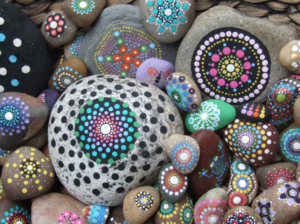
 D5 Creation
D5 Creation